
























































































DeLaWare
Rudy Marine | 302.945.2254 32606 DuPont Blvd, Dagsboro, DE rudymarine.com
North Bay Marina | 302.436.4211 36543 Lighthouse Rd, Selbyville, DE northbaymarina.com
STEERING
Rt 113 Boat Sales | 302.436.1737 52 Cemetary Rd, Selbyville, DE rt113boatsales.net
marYLanD
Fairwinds Marina | 410.216.0205 1000 Fairwinds Dr, Annapolis, MD 21409 fairwindsmarina.com
Tri-State Marine | 410.562.6247 7320 Edgewood Rd, Annapolis, MD tristatemarine.com
Annapolis Inflatables/Fawcett Boat Supplies 410.267.8681
919 Bay Ridge Rd, Annapolis, MD annapolisinflatables.net
North Point Yacht Sales | 410.280.2038 7330 Edgewood Rd, Ste 1, Annapolis, MD northpointyachtsales.com
Beacon Light Marina | 410.335.6489 825 Bowleys Quarters Rd, Baltimore, MD beaconlightmarina.com
Annapolis Boat Sales, LLC | 410.604.6962 1629 Postal Rd, Chester, MD annapolisboatsales.com
Tri-State Marine | 410.867.1447 5861 Deale Churchton Rd, Deale, MD tristatemarine.com
Jim’s Marine, Inc. | 410.648.5106 96 East Cross St, Galena, MD jims-marine.com
Bosun’s Maryland | 410.286.1350 411 Winchester Creek Rd, Grasonville, MD bosuns.com/about-us-maryland
Hudson Marine | 410.643.6768 219 Hess Rd, Grasonville, MD 21638 hudsonmarinellc.com
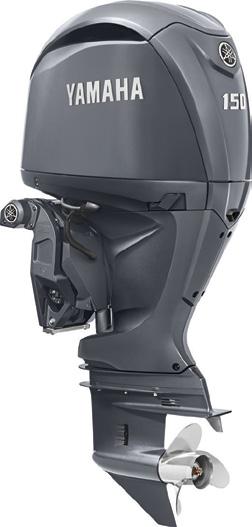
Rudy Marine | 443.995.3785 3033 Kent Narrows Way S, Grasonville, MD rudymarine.com
Anchor Boats, Inc. | 410.287.8280 448 N Mauldin Ave, North East, MD anchorboat.com
Campbell’s Boatyards - Jack’s Point 410.226.5105
106 Richardson St, PO Box 410, Oxford, MD campbellsboatyards.com
Ventnor Marina | 410.255.4100 8070 Ventnor Rd, Pasadena, MD 21122 ventnormarinamd.com Haven Harbour Marina | 410.778.6697 20880 Rock Hall Ave, Rock Hall, MD 21661 havenharbour.com
Virginia
Oyster Cove Boatworks | 804.824.9904 5195 G Washington Mem Hwy, Gloucester, VA oystercoveboatworks.com
Norfolk Marine | 757.461.3391 5221 E Virginia Beach Blvd, Norfolk, VA norfolkmarine.com
Jett’s Marine, Inc. | 804.453.3611 18477 Northumberland Hwy, Reedville, VA jettsmarine.com

Oyster Cove Boatworks | 804.824.9904 27 Campbell Dr, Topping, VA oystercoveboatworks.com
Oyster Cove Boatworks | 757.716.1819 1305 Virginia Beach Blvd, Virginia Beach, VA oystercoveboatworks.com
Legasea Marine | 757.898.3000 821 Railway Rd, Yorktown, VA legaseamarine.com









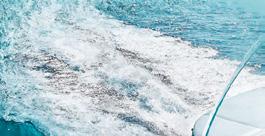



































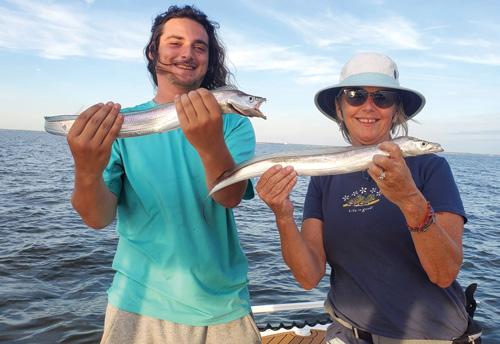

44
Tuna on Topwater
When tuna are up top but ignoring your trolled baits, it’s time to shift gears.
By Lenny Rudow46
Chinco-YES!
Part II: Winter Quarter Shoal and nearby wrecks and reefs.
By Wayne Young48
Brown Trout on Spinning Gear
You don’t need to master fly fishing to enjoy awesome trout action.
By Adam Greenberg51
LT Trolling for Cutlassfish
These crazy, toothy, snake-like critters are cool! By Lenny
Rudow54
Fishboat Upgrade Red Alert
Some new propellers could have you feeling a little loopy.
By Lenny Rudow56
Choosing Reels for Beginners
When on the market for a new reel it’s easy to get lost in the endless sea of options.
By Ian RubinMax smiles over a tuna tempted with a topwater plug.
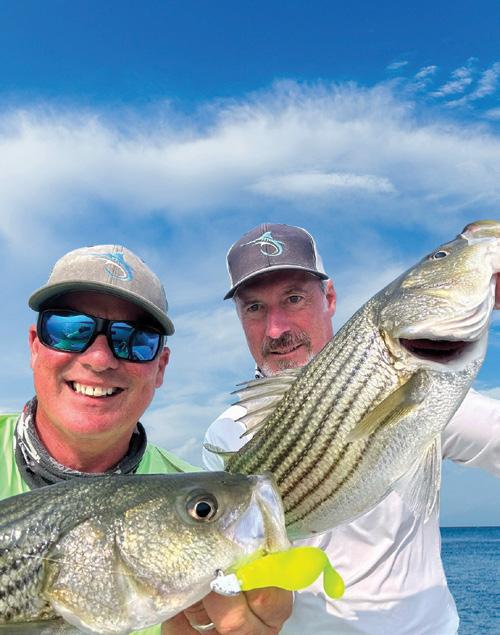
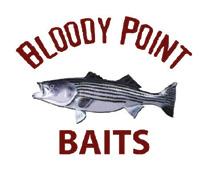
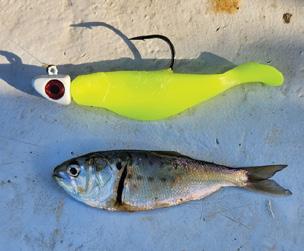

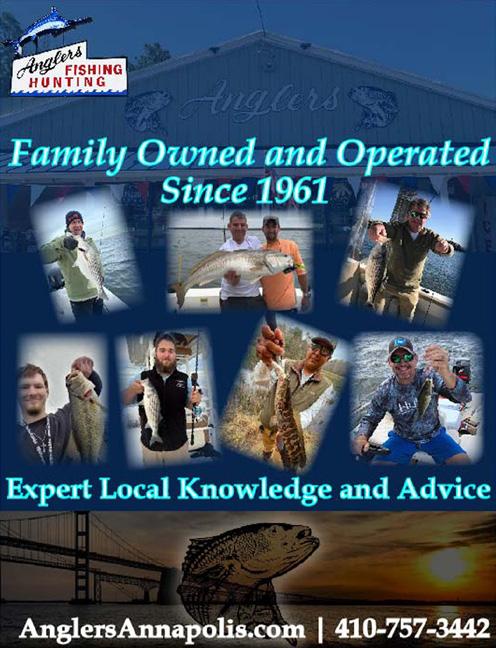


612 Third Street, Suite 3C, Annapolis, MD 21403 (410) 216-9309 FishTalkMag.com
ANGLER IN CHIEF
Lenny Rudow, lenny@fishtalkmag.com
PUBLISHER
Mary Iliff Ewenson, mary@fishtalkmag.com
ASSOCIATE PUBLISHER
Chris Charbonneau, chris@fishtalkmag.com
MANAGING EDITOR
Molly Winans, molly@fishtalkmag.com
SENIOR EDITORS
Beth Crabtree, beth@fishtalkmag.com
Kaylie Jasinski, kaylie@fishtalkmag.com
COPY EDITOR
Lucy Iliff, lucy@fishtalkmag.com
FISHING REPORTS EDITOR
Dillon Waters
ADVERTISING SALES
Katie Lange, katie@fishtalkmag.com
Eric Richardson, eric@fishtalkmag.com
CUSTOMER SERVICE MANAGER
Brooke King, brooke@fishtalkmag.com
DISTRIBUTION / BROKERAGE / CLASSIFIEDS MANAGER
Beatrice M. Roderick, beatrice@fishtalkmag.com
ART DIRECTOR / PRODUCTION MANAGER
Zach Ditmars, zach@fishtalkmag.com

GRAPHIC DESIGNER / PRODUCTION ASSISTANT
Royal Snyder, royal@fishtalkmag.com
TACTICIAN
Craig Ligibel
COASTAL CORRESPONDENT
John Unkart
CONTRIBUTING WRITERS
Alan Battista, Jim Gronaw, Chuck Harrison, Capt. Monty Hawkins, Eric Packard, David Rudow, Wayne Young
DISTRIBUTION
Martin and Betty Casey, Gregory and Dorothy Greenwell, Dave Harlock, Ron and Colleen Ogden, John and Chrissy Wathen
Rudow’s FishTalk is a monthly magazine for and about Chesapeake and Mid-Atlantic anglers. Reproduction of any part of this publication is strictly prohibited without prior consent of the officers of Rudow’s FishTalk LLC. Rudow’s FishTalk LLC accepts no responsibility for discrepancies in advertisements.
Rudow’s FishTalk is available by first class subscription for $45 a year, and back issues are available for $4 each. Mail payment to Rudow’s FishTalk Subscriptions, 612 Third Street, Suite 3C, Annapolis, MD, 21403.
Rudow’s FishTalk is distributed free of charge at more than 850 establishments along the shores of the Chesapeake and the DelMarVa Peninsula. Businesses or organizations wishing to distribute Rudow’s FishTalk should contact the Rudow’s FishTalk office, (410) 216-9309 beatrice@fishtalkmag.com.
Member Of:

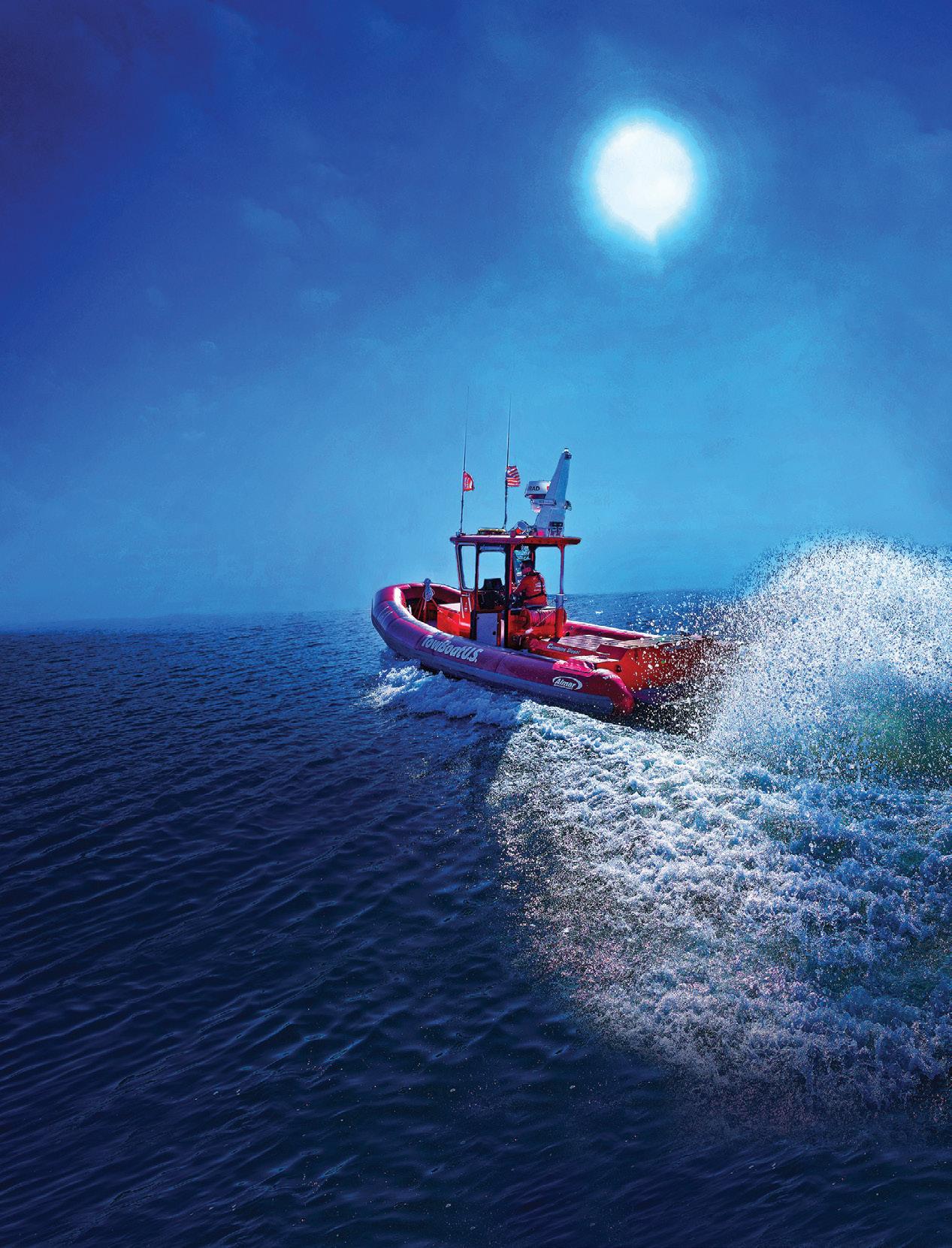

After a lifetime of dreaming and procrastination, I finally did it: I built a boat with my own two hands. I’ll admit that I cheated a bit by buying a kit, which included all the wood and detailed plans for how to cut and mount each and every piece. I must also disclose that I made plenty of mistakes. Many pieces and parts had to be recut, and a large debris pile rapidly formed in my workspace. But I did it! I completed a hand-crafted Chesapeake Bay deadrise workboat.
Then I smashed a hole in the bottom, weighed it down with rocks, and sunk it.
All 24 inches of that handcrafted glory now resides on the bottom of my aquarium, surrounded by filtering oysters, swaying ghost anemones, and fan-waving barnacles. Striped blennies and skillet fish swim in and out of the cabin and mud crabs crawl through its holed bottom. Bay anchovies, mummichog minnow, and silversides circle above the bent VHF antennae and ¾” scale spotlight. And every time I glance its way I’m amazed at the richness of life we enjoy here in Chesapeake Country; each and every resident came straight out of the South River.
To stock the tank, my daughter and I pulled an eight-foot seine net through a few yards of very unremarkable, murky-looking, kneedeep water in the river — and came up with dozens of flipping finfish and grass shrimp on just about every pass. The net held plenty of surprises, too like quartersized blue crabs and inch-long croaker. We anglers gaze across the Bay’s waters and see endless ripples, often clueless as to just how shockingly dense the life is beneath those waves. And we’re the
lucky ones. Being anglers, we see far more of it than most people. Decades ago when I worked for the Lady Maryland Foundation (now called Living Classrooms) we took groups of school kids out on the Patapsco, and it never failed to amaze me how few of them had any inkling of what swam in their own backyard. In a class of 20 children there might have been one or two who had been fishing on the Bay and had seen bluefish or spot, but even they
are you’ve never encountered one. And those blennies? Though untold numbers live in the Bay they’re a mystery to 99.9 percent of the people living in its watershed.
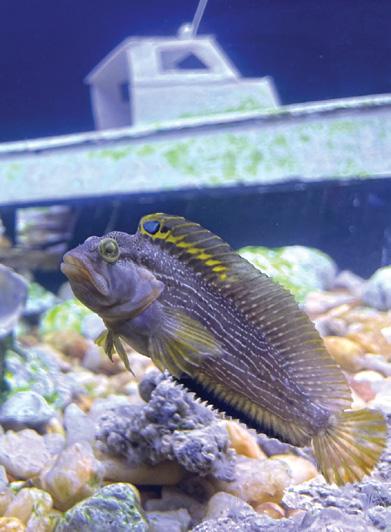
were left slack-jawed by the loads of life we pulled up in our small otter trawl. How many of us have ever held a hogchoker? Those flounder-like fish literally pave the bottom in some areas, yet we rarely see them because they don’t feed in such a way that they’d ever take a hook. How many of us have spied a skillet fish? Unless you’ve handled piles of oyster shell freshly pulled out of the water, chances
This, fellow anglers, is one of the main reasons why our politicians and our society lack the will to do what is necessary to restore Chesapeake Bay. It’s why we sink $10 million dollars into efforts that require $100 million. It’s why there are hundreds of millions of tons of sediment laced with nitrogen and phosphorus sitting behind Conowingo dam at this very moment. It’s why sewage spills so significant they trigger health warnings still occur each and every summer up and down the Bay’s shores. And it’s most certainly one of the reasons why you and I have to sort through a morass of rules just to go fishing, as our regulators try desperately to find ways of supporting fish populations that struggle to survive in a degraded aquatic environment. Here’s your call to action: This summer, find a neighbor, co-worker, or friend who has never been out on the Bay, and take them fishing. Give them a glimpse of what’s out there. Help them understand that underneath those waves there’s a vibrant world of life that deserves our attention, our effort, and our support. If you have kids, get a seine net to haul with them. And if you have an old aquarium sitting dry and dusty in your garage, start building a boat. Because the only way we can ever hope to restore the Bay is by getting the other 18 million people living in its watershed to see what’s out there and really, truly care.





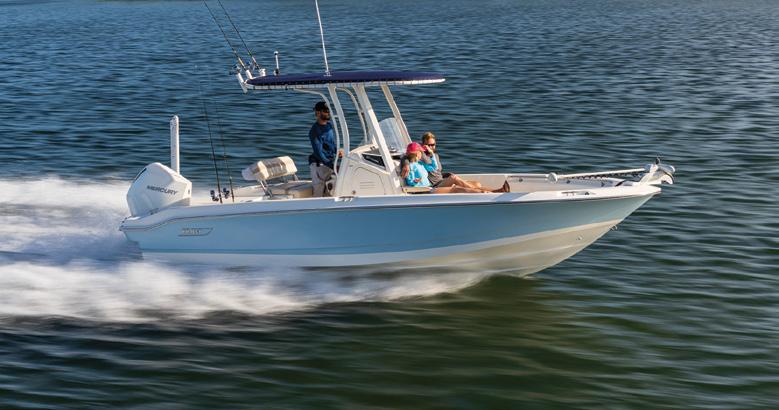



Dear FishTalk, Iread the piece about how we need an app to track the catches of recreational anglers, but there are already several out there we could start using. eTRIPS, Got One, maybe even the iAngler app could be used in this fashion.
-Brad T., via Facebook IM
Dear Brad, Yes, you are correct! That article was intended to be purely sarcastic — although a lot of folks didn’t take it that way. In 2022, Maryland assembled a “Task Force on Recreational Fishing Data Collection and Licensing,” which I served on. Its recommendation was to use an app such as these. Unfortunately, almost two years later we have yet to see that recommendation employed.
-Lenny R.Send your fish photos, questions, and comments to lenny@fishtalkmag.com
Q: Why did the crab cross the Bay? A: To get to the other tide. -Anonymous
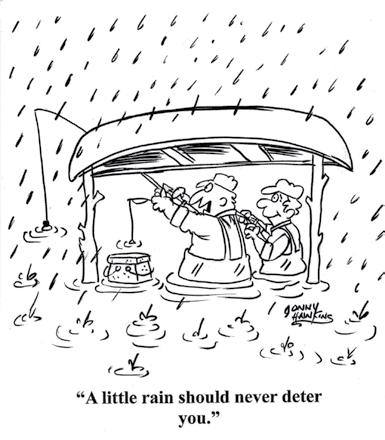

Tune in Thursday, July 11, 2024 at 6 p.m. for a new episode!
Presented by
New episodes air on the first Thursday of the month on our Facebook page (facebook.com/fishtalkmag) and YouTube channel (youtube.com/fishtalkmagazine). View past episodes at fishtalkmag.com/live-with-lenny
Scan this code to follow us on Facebook and YouTube or sign up to get notified about upcoming LIVE video streams via email at fishtalkmag.com/live-with-lenny
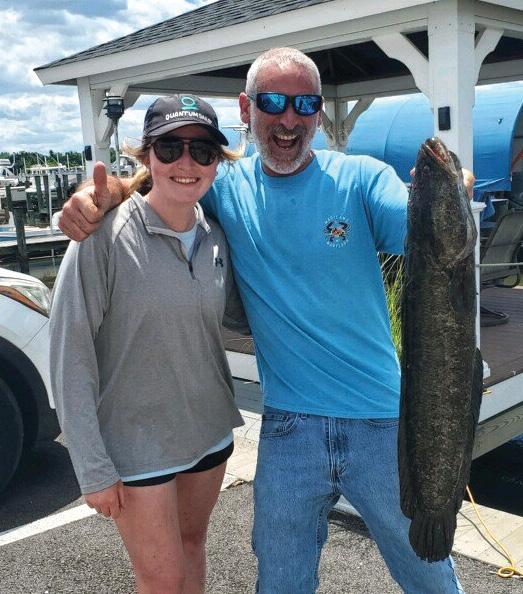

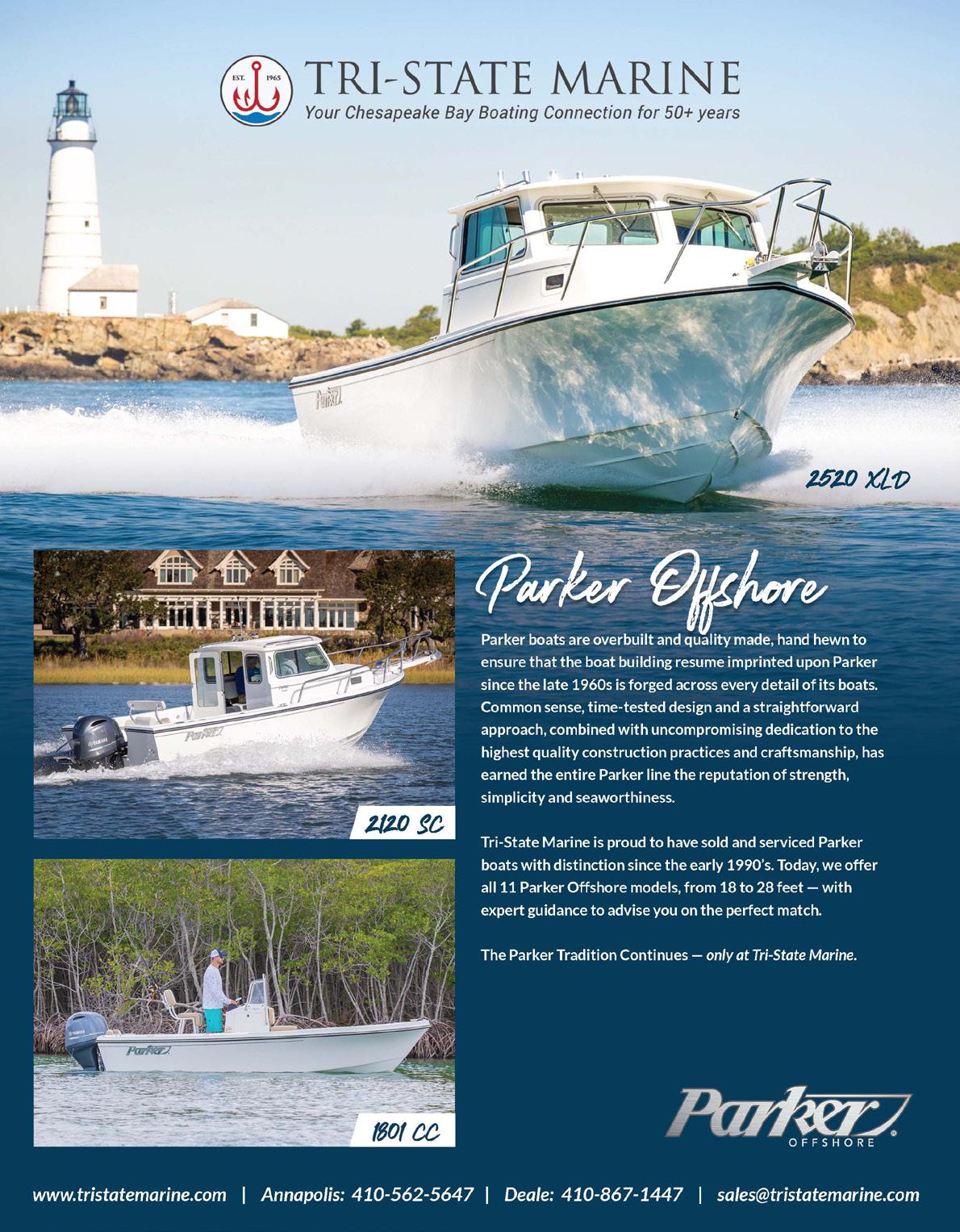

 By Lenny Rudow
By Lenny Rudow
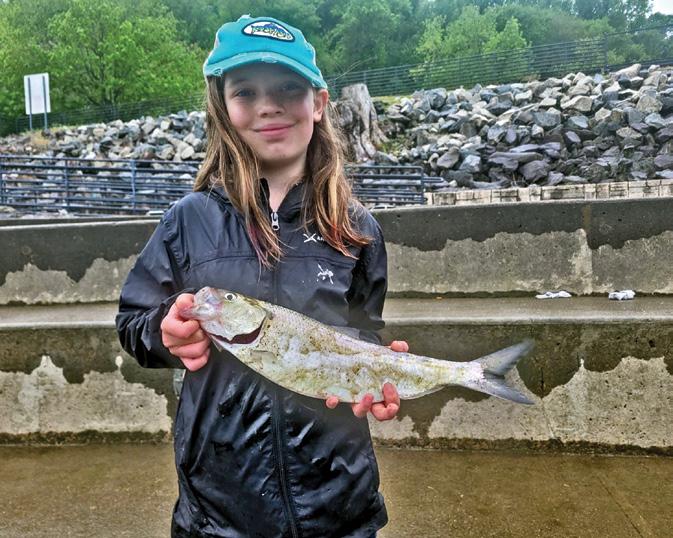
On Earth Day Virginia governor Glenn Youngkin and representatives from the Virginia Marine Resources Commission (VMRC), the Virginia Institute of Marine Science, and NOAA celebrated the completion of over 200 acres of restored oyster habitat in the lower York River. Part of the Chesapeake Bay Program’s restoration plans for 10 Bay tributaries to be completed by 2025, this largescale alternative-substrate planting project reaches the stated goals for York River oyster repopulation. The VMRC says they’re confident it can be replicated on a global scale.
Wilmington, DE’s Eastside has a new launch ramp and fishing area, the results of a $2.9 million investment of funds provided by the Federal Aid in Sport Fishing Restoration fund and settlement money from a 2004 oil spill in the Delaware River. The 7th Street Boating and Fishing area is now open with a new ramp and courtesy dock, new decking and rails on the fishing pier, new lighting, and a trailer-friendly expanded parking lot. The Delaware Department of Natural Resources and Environmental Control (DNREC) also announced the reopening of the Mulberry Landing boat ramp near Bethany Beach, with an expanded and repaved entry and parking lot. And the Scotton Landing ramp near Magnolia has also reopened with improvements including a new ramp that extends deeper than the old one, a new courtesy dock, and a repaved parking lot. WTG, DNREC!
The Maryland DNR has confirmed that inveterate angler and former FishTalk cover model Lucy Perez recently joined the coveted crew meeting the state’s Master Angler requirements. She landed her final qualifying fish, a 22-inch American shad, crowning off catches including a 27-inch pickerel, a 33-inch carp, and seven other highly rated catches. While attaining this status is in and of itself a notable achievement, Lucy is the youngest person ever to make it and is also the first female Master Angler in the entire state. WTG, Lucy!
With striped bass populations reaching critical stages, the Maryland DNR has upped its efforts to monitor reproductive success including a larval striped bass survey. Initiated last year, scientists are now adapting egg and water quality surveys and testing egg and larval habitat-related hypotheses. Measurements taken include temperature, salinity, dissolved oxygen, and pH, and plankton nets are used for egg and larvae collection at 10 different sites. According to last year’s results, striped bass experienced poor feeding conditions due to a mismatch of larvae and zooplankton blooms which resulted in low larval feeding. According to DNR scientist Jim Uphoff, they hope to soon have enough data to publish a study on the larval feeding results.








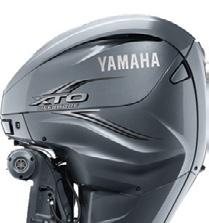
The battle over blue catfish continues in Maryland waters of the Chesapeake, as the state announced the commercial harvest of this invasive species continues to climb—but not fast enough. Over four million pounds of blue cats were harvested in 2023, an increase of over 500-percent in the past 10 years, yet in some tributaries of the Chesapeake blue catfish are known to make up 75 percent of the total biomass of fish. In the Patuxent River, surveys have shown a shocking 500 blue catfish per hectare at some locations.
The state is counting on recreational anglers, as well as commercial fishermen, to help bring the blue cats under control. Anglers are asked to remove and kill rather than release fish they don’t plan to eat. It must be pointed out that blue cats don’t taste like most catfish and have a firm, white, mild meat that many people consider to be excellent. Everyone is also encouraged to join the Coastal Conservation Association’s Great Chesapeake Invasives Count (get the details at ccamd.org), which is free to join and awards great prizes to anglers registering their catches every month (tune in to Live with Lenny on the FishTalk Facebook or Youtube channels, at 6 p.m. the first Thursday of the month, for the prize drawings).


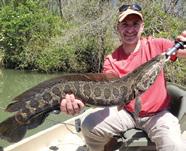
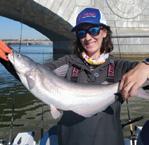








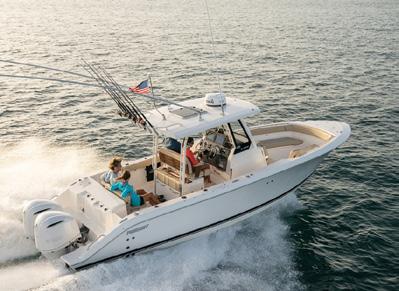


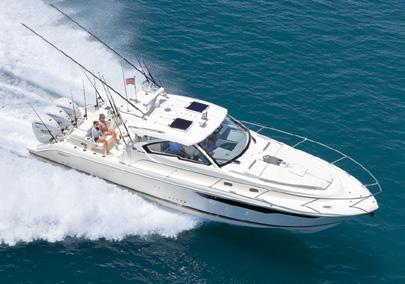








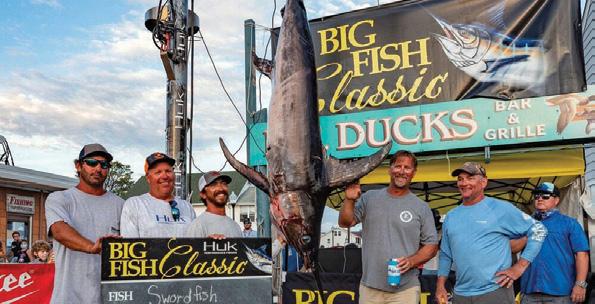

Delaware
North Bay Marina | 302.436.4211 36543 Lighthouse Rd, Selbyville, DE northbaymarina.com
Carlisle’s Marine | 302.389.0100 49 Artisan Dr, Smyrna, DE carlislesmarine.com
Maryland
Fairwinds Marina | 410.216.0205 1000 Fairwinds Dr, Annapolis, MD fairwindsmarina.com
Bosun’s Marine Maryland | 410.286.1350 411 Winchester Creek Rd, Grasonville, MD bosuns.com/about-us-maryland Total Marine | 410.604.6000 106 Wells Cove Rd, Suite 2, Grasonville, MD totalmarine.com
PYY Marine | 410.255.1771 1132 Pasadena Yacht Yard Rd, Pasadena, MD pyymarine.com
Richardson Marine | 410.745.9279 9649 New Rd, McDaniel, MD 21647 richardsonsmarinerepair.com
Thornes Marine | 410.957.4481 1237 Greenbackville Rd, Stockton, MD thornesmarine.com
July 26 to 28 is the Big Fish Classic, which now lays claim to having the largest swordfish payout on the planet ($1.2 million for a 2021 catch that broke the Maryland state record). Boats choose a 32-hour time slot to fish and may depart from New Jersey to Virginia but must fish within 125 nautical miles of the Ocean City sea buoy. Anglers need not adhere to IGFA rules; however, there is a list of dos and don’ts, so check the rules carefully at bigfishclassic.com before competing. The biggest qualifying fish wins.
The 37th annual Ocean City Tuna Tournament is scheduled for July 12 to 14 this summer, hosted by the Ocean City Fishing Center. With payouts regularly hitting the million-dollar mark for several years running, this is a highly competitive, big money event that draws a huge number of boats—last year’s field included 74. Boats fish two of the three days, with angling taking place from 7 a.m. to 3 p.m. Boats may also depart from Indian River, DE, and all boats must fish within 100 miles of the Ocean City Sea Buoy. This is a trolling-only, no green stick, IGFA rules applicable tournament. Visit octunatournament.com to learn more.
# Tournament anglers will be working hard to get tunas into the boat this July.

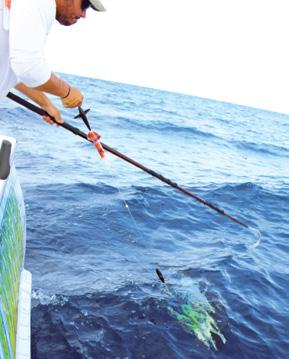












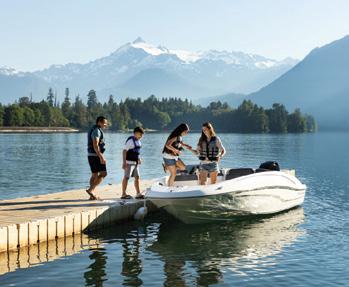

Embarking on the open water is an exhilarating experience, lled with the promise of adventure and relaxation. Whether you’re a seasoned sailor or a weekend cruiser, safeguarding your vessel with proper insurance is not just a choice—it’s a necessity. Explore the reasons why every boat owner should prioritize boat insurance for a worry-free voyage.
The open water can be unpredictable, with unexpected storms, collisions, or other potential accidents. Boat insurance can give you nancial protection if there is damage to your vessel, providing coverage for repairs or replacement.
Accidents on the water can result in damage to other boats, docks, or even injuries to passengers. Boat insurance offers liability coverage, which can pay for damages or injuries you’re liable for while boating, up to speci ed limits, and lawsuit costs if you’re sued. This includes damage you cause to another watercraft or if someone on or near your boat is injured and you’re found to be legally responsible.
Unfortunately, boat theft and vandalism are realities that boat owners face. Boat insurance has comprehensive and collision coverage that can protect you against events outside of your control, including theft and vandalism.
Accidents on the water may lead to injuries for you or your passengers. Boat insurance offers a range of optional medical payments coverage limits, helping to cover medical expenses if you are in an accident or someone is hurt on your boat, regardless of fault.
If you nanced the purchase of your boat, most lenders require insurance coverage to protect their investment. Having boat insurance not only ful lls these requirements but also gives you peace of mind knowing that your nancial interests are safeguarded.
Some water municipalities and marinas may require proof of insurance for docking or accessing certain areas. Boat insurance allows you the exibility to explore different destinations without worrying about entry restrictions.
Progressive boat insurance can include optional Sign & Glide® On-Water Towing coverage. If your boat is disabled or breaks down on the water, Sign & Glide® pays for on-water towing, jump starts, soft un-groundings, and fuel delivery.
Wreckage removal
If your boat sinks, Progressive boat insurance will cover the cost of removing your boat from the water (if removal is legally required).
Investing in boat insurance is not just about protecting a valuable asset; it’s about safeguarding the memories, experiences, and joy that come with your on-water adventures. Don’t let unforeseen circumstances disrupt your journey—navigate with con dence, knowing that Progressive boat insurance has you covered. Ensure a smooth and worry-free voyage, because when it comes to your boat, peace of mind is the ultimate luxury.
Editor’s Note: We wish we could personally test every item that appears on these pages, but that simply isn’t possible. So that you know the difference between when we’ve physically tested a piece of gear and when we’re writing about it because it’s newsworthy and we think you’ll want to know about it, we’ve developed this FishTalk Tested button. When you see it printed next to something in this section, it means we’ve personally run it through the wringer.
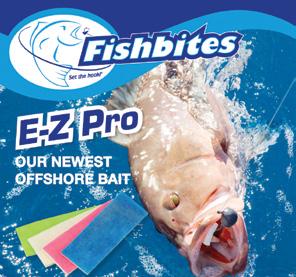
Fishbites has a new trick up its sleeve for oceanic anglers with E-Z Pro. Designed for offshore bottom fishing, these bait bites are made with their Longer Lasting formula plus a cloth binder in the middle. That boosts durability so you don’t have to worry about losing your bait after a missed strike and can keep those hooks down there where they belong. E-Z Pro comes in shrimp, crab, and squid, and like their other offerings provides all the scent and attraction of the real thing but with no mess and no refrigeration necessary. Also from FishBites for 2024…
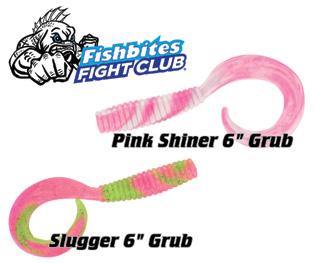
There’s news from Fishbites’ Fight Club line, too. These lures are infused with the same flavor and scent technology as Fishbites artificial baits, and for 2024 they have some new color options: Slugger and Pink Shiner. Slugger is a green-pink large-profile twister tail with glitter, which reminds us a lot of the patterns often called Electric Chicken. Pink Shiner is a pink/ white combination. Anglers familiar with soft baits featuring baked-in flavors and scents know that color choices are often limited and these two new options expand the appeal of Fishbites’ patented hydrogel lures, which don’t dry rock-hard on the hook nor add PVCbased plastic into the environment every time you lose a lure. There’s only one question left: are you ready to rumble? Price: $6.99/4-pack 6” grubs. Visit fishbites.com if you want to scrap.

e’ve mentioned Tinman Lures Floaters on these pages before but they warrant a revisit, because after using them for a period of time we’ve made an interesting discovery: although they’re generally used for flounder fishing, it turns out these things are killers for blue catfish. Yes, you read that right – catfish. Blue cats don’t sit in the mud like some catfish, but are active through the water column and often fishing a floated bait just off bottom is more effective than letting your offering sit as though dead. In fact, during last year’s Fish For a Cure, FishTalk’s own Zach Ditmars caught the largest fish registered in the entire competition, a 33” blue catfish, while using one. Rig them about three feet above a three-way swivel or fishfinder, add a chunk of cut fish and hold on tight! Price: $3 to $4; visit Tinmanlures on ebay.
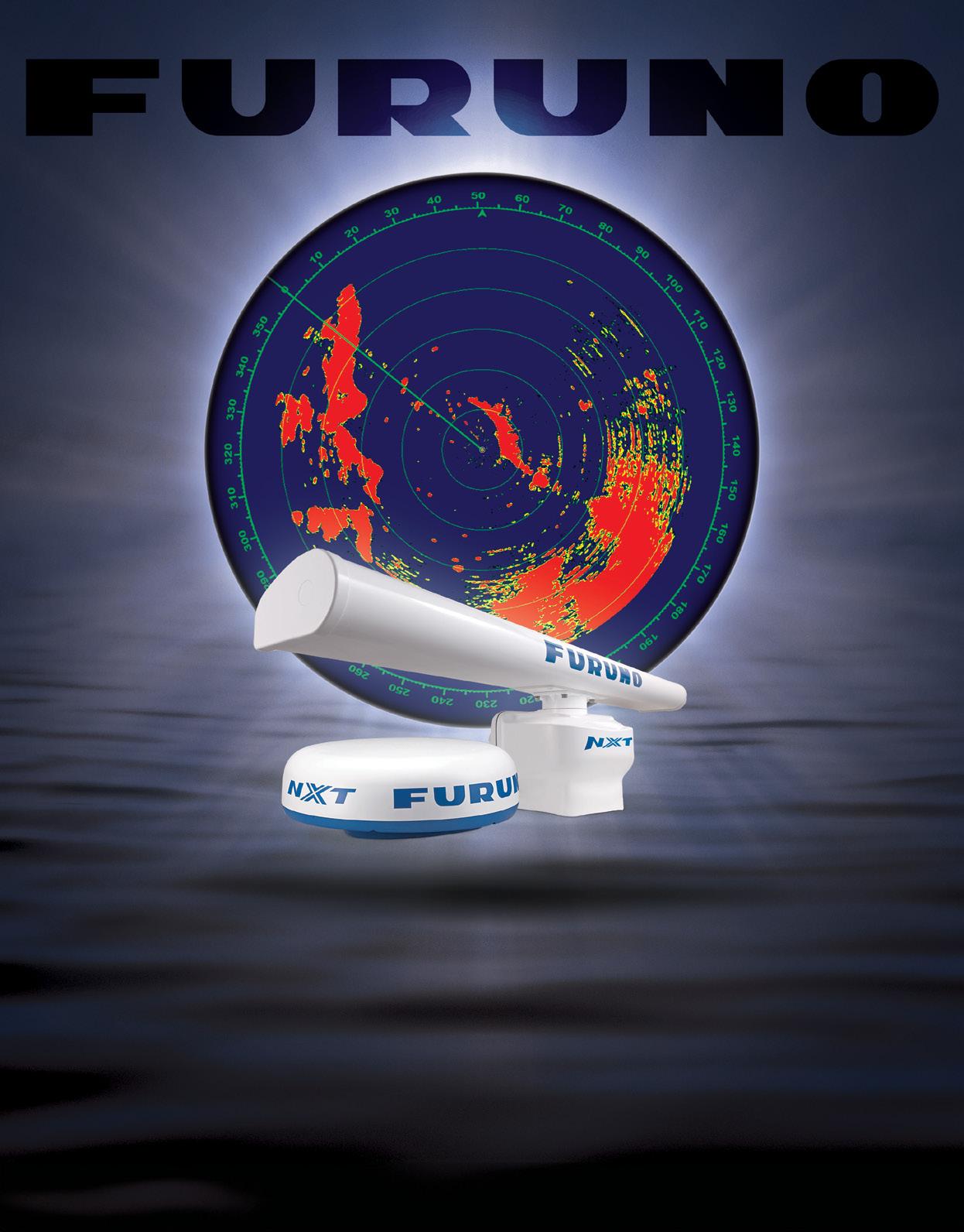

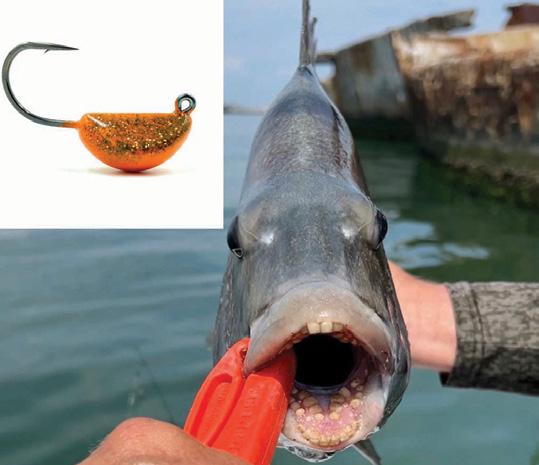
Prior to taking a trip targeting sheepshead we ordered up some standup (bottom sweeper style) jigs, caught fish on ‘em, and then after the fact realized that they were from a local company based in Virginia Beach, VA. End Game Tackle’s Sheepshead and Tautog jigs are powder-coated with a multitude of color patterns (green pumpkin rocked it for us), are rigged with black nickel 2X hooks, and come in half- to one-ounce sizes. We took note of two standout features: first, they take care to leave the hook eye free of powder coat, eliminating the always-annoying process of punching it open before tying one on. Second, this powder coat finish is uber-tough and doesn’t instantly chip off when you bounce the jig off concrete or rocks, like some. Price: $9.99/2pack. Visit endgametackle.com to learn more.
I’m fumbling with my notepad trying to read the chicken-scratch that I can’s see because I forgot my cheaters, when the Hook Optics guys come to my rescue with a pair of magnifying glasses then insists I try a pair of Hook Knot Ty’er sunglasses. You guys with crisp young eyes can tune out, but we old fogies need a helping hand to see things like thin diameter leaders and small hook-eyes. The Knot Ty’ers are now available with gray or brown polarized lenses which have a small bifocal patch in the bottom of the lenses that magnify 1.5, 2.0, or 2.5 times, so making all those twists and loops will be a breeze. Plus, the matte black frame style is open and uber-light. Price: $99. Visit hooksunglasses.com to see what we’re talking about.

Hold the phone because I just found my new favorite sun hoodie. I’ve never been a huge fan of long-sleeve sun protection shirts because either a) I get too hot, b) they get smelly, c) they aren’t super comfortable, or d) all of the above. This is not the case with the women’s Bamboo Shade Hoodie II from Free Fly Apparel. This is the second generation of this popular style, now with an updated and super dialed-in fit. The fabric is stretchy and buttery soft (68 percent viscose from bamboo, 29 percent polyester, 3 percent spandex), so comfortable you could sleep in it or wear it all day fishing, and it’s stylish enough to easily transition from the boat to a bite in town. It also features a relaxed hood for increased protection, and thumbholes keep sleeves in place while also offering sun protection for the backs of your hands. But what really sold it for me is the fact that this hoodie offers UPF 50+ protection, it’s naturally odor resistant, and is even temperature regulating, meaning it’ll keep you at that just-right temperature, even when the forecast throws you for a loop. I’ve worn mine while spring fishing on the Chesapeake when the temperature goes from 75 degrees one day to 50 the next, and I’ve worn it all day in the hot Florida sun while fishing for redfish and did not even break a sweat. Offered in a variety of colors; $74 at freeflyapparel.com






ou know those paracord wraps that can turn a steering wheel into a grippy work of art? You could spend hours and hours customizing your boat’s wheel with one — if you know how — or you could enlist the services of a pro. Annapolis local Jake of @getagripwraps, a college student back home for the summer, is a wheel-wrapping sharpie looking to make your boat look better and create his own summer business at the same time. Price: $140 to $220. Email jakeciuba11@gmail.com or DM @getagripwraps on Instagram to find out more.
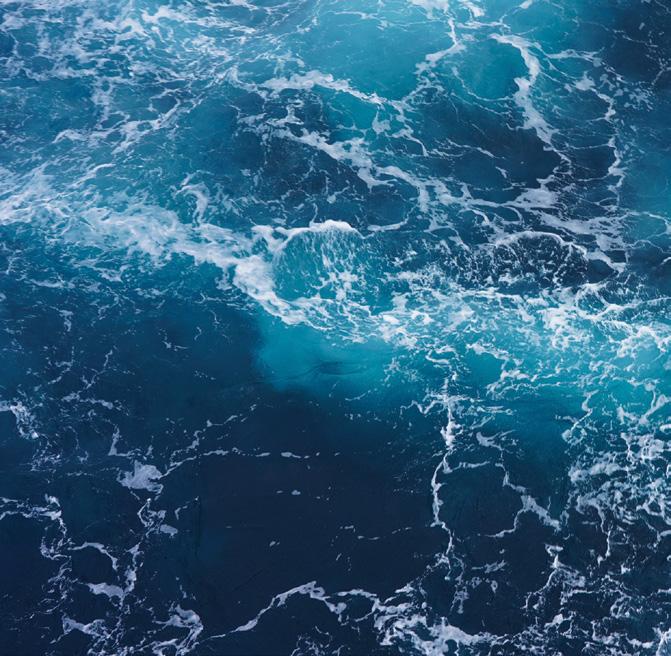


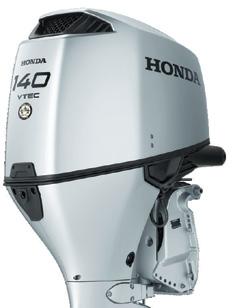

Those plastic fish grips in your tacklebox may get the job done, but why have a simple, effective fishing tool when you could have one with Bluetooth and an app?! That’s the concept behind the Halasz Multifunction Fish Grip, which doesn’t merely lock on the jaws of your prized catch but can also measure and weigh your catch then transmit the data to your phone. And believe it or not, according to the manufacturer this fish grip can be used whether you’re right-handed OR left-handed — unlike any other fish gripper on the face of the planet. The manufacturer also says it “passed the waterproof test,” though it doesn’t say exactly what sort of test that was, but we’re 100-percent confident that a tool like this utilizing Bluetooth and batteries is going to be completely impervious to moisture. We do caution that they say “viscosity of fish may cause malfunction,” but how many fish do you know of that are viscosity-ish? Price: 1980 Yuan (about $275 — what we’d call a real bargain!) For more information visit… sorry, Kaspersky blocked it.

This month Capt. Kayla Haile of River Queen Guide Service joins us for some smallmouth bass fishing Q & A.
Q: What are your top tips for targeting smallmouth in rivers?
A: Check the river conditions… I am always checking the river gauge online to see what the flow of the river is. This can be key for what areas I am going to focus on fishing. When there’s a river rise that can get the fish active and feeding on bait fish that are becoming disoriented. Second, I you think you’ll need it BRING IT. I always bring the entire tackle box with me. There have been many days where it takes me going through all my tackle to figure out what pattern the smallmouth are liking best. It can change daily, so I always bring a little bit of everything to make sure I have all my bases covered.
Q: Give us the lowdown on your favorite tackle for the task.
A: My first of two go-to set ups for smallmouth bass fishing is a medium spinning rod with a 1500-size reel and 10-pound braid. I tend to use this rod the most for my finesse fishing techniques like a Ned rig or tube fishing. You want something with a fast-action tip to allow for more sensitivity to feel the bottom when dropping the tubes or Neds, and in colder months, to feel that tapping thump when the fish is eating the lure. I also like a fluorocarbon leader of 12 or 15 pounds because where I fish there are rocks and structure. The leader helps prevent the fish from rocking you and breaking the line. My second choice would be a mediumheavy casting rod rigged with a 150-size reel and 10-pound braid. I use this rod for more action-style baits like spinnerbaits, jerkbaits, crankbaits, topwater, and chatterbaits.
Q: You take a lot of people fishing. What’s the most common mistake you see them make?
A: People not being able to feel the baits. This mainly falls on finesse fishing. Having the correct size heads and sensitive rods are key when trying to work a finesse
bait across the bottom. Many smallmouth feed on crayfish and hellgrammites which lie on the bottom of the rivers so the smallies are searching for these baits when they come out from rocks or off the bottom. When they see that Ned rig or tube bounce from off the bottom of the river this gives a natural look to the bait and something smallies just can’t resist.
Q: All anglers like to fish whenever they can, but summer is probably not your first pick for smallmouth (or maybe it is?). Tell us what your favorite season is for pursuing them, and why.

Q: Open mic — if you could say anything to all the anglers out there, what would it be?
A: My personal favorite is fall or early winter. Many people do indeed like to fish for them in the summer months but the bite windows are either super early morning or late evenings. The river temperature gets to a certain level and can get almost too hot for fish to move around. In the fall the fish start to feel the temperature drops at night and are on the feed to fatten up for winter. Also, fall is when the spinnerbait and jerkbait bites pick back up and in my personal opinion there is no better feeling than a fish eating your lure like it’s having its last meal.
A: My biggest tip I like to give anglers is don’t be afraid to learn and go through some trial and error phases. To this day I am still out there looking for something new to explore and try differently. Today it seems like everyone wants immediate results, but you have to apply many different scenarios that you’ve tried in the past in order to get into a situation that will produce results. I also highly recommend keeping a logbook. This has been one of the key components to having successful trips, especially when it comes to river fishing because the river is constantly changing with fluctuating water levels, temperatures, and clarity. All affect how or if the fish are going to be active. I log everything, the good and bad, to help me pinpoint what my next plan of action will be.
You can contact Captain Kayla on Facebook at River Queen Guide Service, on Instagram @riverqueenguideservice, via email at kaylahaile@hotmail.com, or call/text (443)465-2193.
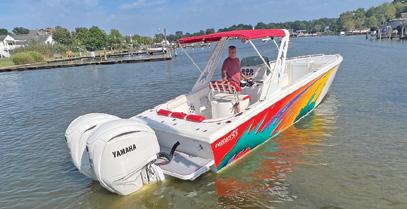
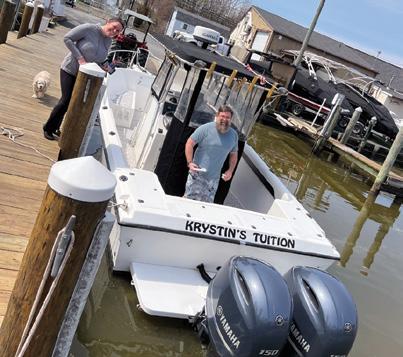






3 Rock hall fireworks
Fireworks over the harbor at 9 p.m.
The Independence Day parade takes place Thursday, July 4 at 10 a.m.
3 salute to cecil county Veterans 4 to 10 p.m. at the North East Town Park in North East, MDF. Veterans’ service organizations, food vendors, rubber ducky race, face painting, and more. The official ceremony begins at 8 p.m. and the evening concludes with fireworks over the water.
4
13th annual solomons island fourth of July Boat Parade
Location: 8.331264 by 76.450065 (up Mill Creek) in Solomons, MD. The starting cannon will sound at noon. Show your American pride and dress up your boat or your person and join in the fun. Follow the boat in front of you and do not lag behind (must be able to do 6 mph); safety first. No registration, just show up. For more information, please contact Melissa. mccormick101@gmail.com and stay on channel 68 the time of the parade.
4 annapolis fourth of July celebration
The Fourth of July parade runs 6:30 to 8 p.m. and kicks off at Amos Garrett and West Street. Fireworks begin at 9:15 p.m. from a barge in Annapolis Harbor.
4 Baltimore fourth of July celebration 1 to 10 p.m. at various locations around Baltimore’s Inner Harbor.
4 fourth of July great american Picnic and fireworks
5 to 10 p.m. at Town Point Park along the Downtown Norfolk waterfront. Enjoy allAmerican fare, live music, and fireworks over the Elizabeth River, beginning at 9:30 p.m. Free and open to the public; presented by Norfolk Festevents.


4
fourth of July in kinsale, Va
Live music, food, drinks, and vendors will be at The Slips Marina, where the crowd will gather to celebrate and watch fireworks launched at 9:30 p.m. over the Yeocomico River.
4 fourth of July in yorktown Patriotic parade, games and fun activities, festive music, and fireworks over the York River at 9:15 p.m.
4 fourth of July stars in the sky 6 to 9:15 p.m. at Victory Landing Park in Newport News, VA. Great food, live music, festive entertainers, giveaways, and a spectacular fireworks display above the James River.
4
Queen anne’s county independence Day celebration
Starting at 6 p.m. at the Chesapeake Heritage and Visitors Center in Chester, MD (free parking). There will be activities for children, live music, food trucks, and fireworks at 9:15 p.m. Rain date July 5.
6
middle River fireworks
Extravaganza
Fireworks will take place at dusk (approximately 9:15 p.m.). The barges will be anchored just outside the sixknot zone in Middle River. Presented by the Marine Trades Association of Baltimore County.
6 st. michaels fireworks
Fireworks in St. Michaels Harbor are scheduled for shortly after dusk with a rain date of July 7. The Chesapeake Bay Maritime Museum will host Big Band Night from 7-10 p.m. (admission $7 for members, $12 non-members).
10 frederick saltwater anglers monthly meeting Food starts at 6 p.m. followed by meeting at 7 p.m. at 289 Willowdale Drive, Frederick, MD 21702. Each meeting has a speaker, vendor, prize raffle, and 50/50.
12-14 37th annual ocean city tuna tournament
Hosted by the Ocean City Fishing Center. Boats fish two of the three days. This is a trolling-only, no green stick, IGFA rules applicable tournament. All boats must fish within 100 miles of the Ocean City Sea Buoy.
12-14 fsa summer slam
Presented by the Frederick Saltwater Anglers in Deltaville, VA.
12-14 Potomac Jazz and seafood festival
Featuring music from nationally renowned jazz artists and delicious local seafood, this three-day event includes a variety of activities for jazz enthusiasts along the beautiful Potomac River at the St. Clement’s Island Museum in Colton’s Point, MD, and in the charming Town of Leonardtown.
13-14 cca sandy Point state Park Reef Ball Building
Roll up your sleeves for habitat! CCA Maryland is pleased to partner with Defensores de la Cuenca to host a two-day artificial reef ball building project at Sandy Point State Park. Free, family-friendly event. RSVP at ccamd.org
20
anne arundel county River Days
11 a.m. to 4 p.m. at the Annapolis Maritime Museum. Each festival will feature fun activities for all ages, including water activities, environmental educators, boat rides, live music, food trucks, games, crafts, face painting, county agencies, and more. Registration to the festivals is free and required for entry, as capacity is limited. Registration does not include boat ride tickets or kayak lessons, which are also free but must be reserved separately for a specific time slot. Registration opens June 20 at 12 p.m.
20 chesapeake Bay Paddle
An epic day of paddle races and a post-paddle festival to celebrate and help protect the Chesapeake Bay. Hosted by Kent Island Outrigger Canoe Club. 35-mile, 10-mile, and 3.2mile course options. Kent Island, MD.
22 caPca monthly meeting 7 to 8:30 p.m. online via Zoom. Topic: Farewell to traditional nautical charts. Ryan Wartick, a veteran of Navy and NOAA Corps Sea Service, will talk about the transition from paper to electronic navigation charts (ENCs) and how the underlying hydrographic data is supplied to current chart plotters. He will also describe how that data will continue to be the basis for alternate sources of paper charts. Free. The Zoom link will be posted at capca.net one week before the program.
25 combos for kids


Combos for Kids provides fun opportunities to celebrate and enrich the lives of children and their families through the sport of fishing. Presented by Anglers Sport Center. At Mike’s Beach: Baltimore County Police youth outreach (boats needed - crabbing). Contact: EJ Harman, (410) 299-2693.
26-28 11th annual huk
Big fish classic Boats choose a 32-hour time slot to fish and may depart from New Jersey to Virginia but must fish within 125 nautical miles of the Ocean City sea buoy. Anglers need not adhere to IGFA rules; however, there is a list of dos and don’ts, so check the rules carefully.
st 9-11, 2024 Augu
Come by land or sea to the Town of Rock Hall for a Pirates & Wenches Theme Party you won't soon forget


Chesapeake Calendar presented by


st. michaels concerts in the Park series
The St. Michaels Community Center hosts its waterfront Concerts in the Park Series at Muskrat Park in St. Michaels each Thursday from 6 to 7:30 p.m. with plenty of shade, treats, and water for sale.
5-9
51st annual White marlin open
The world’s largest billfishing tournament. In Ocean City, MD.
6 combos for kids
Combos for Kids provides fun opportunities to celebrate and enrich the lives of children and their families through the sport of fishing. Presented by Anglers Sport Center. At Mike’s Beach: S.A.F.E./ KPIPP Kids Play in Patterson Park - Bob’s Kids (boats needed - crabbing). Contact: EJ Harman, (410) 299-2693.
Pirates & Wenches Weekend
Come by land or by sea to Rock Hall, MD, and experience a town-wide family-friendly theme party everyone will enjoy.
11
anne arundel county River Days
11 a.m. to 4 p.m. at West River Center (5100 Chalk Rd., West River, MD). Each festival will feature fun activities for all ages, including water activities, environmental educators, boat rides, live music, food trucks, games, crafts, face painting, county agencies, and more. Registration to the festivals is free and required for entry, as capacity is limited. Registration does not include boat ride tickets or kayak lessons, which are also free but must be reserved separately for a specific time slot. Registration opens July 11 at 12 p.m.
14 frederick saltwater anglers monthly meeting
Food starts at 6 p.m. followed by meeting at 7 p.m. at 289 Willowdale Drive, Frederick, MD 21702. Each meeting has a speaker, vendor, prize raffle, and 50/50.
17 18th annual youth fishing Derby
Sponsored by the Kent Island Fishermen, Inc. and the Kent Island Estates at Romancoke Pier on Kent Island. 8 a.m. registration, 9 to 11 a.m. fishing, 11:30 a.m. to 1 p.m. prizes and refreshments at the Kent Island American Legion 278. Age groups: 3-5, 6-10, and 11-16. Bring your rods (minimal number of loaner rods available), bait provided.
25 anne arundel county River Days
11 a.m. to 4 p.m. at Quiet Waters Park, Annapolis. Registration is free and required for entry; registration opens July 25 at 12 p.m.
For links to the websites for these events fishtalkmag.com/calendar
Here’s How it w orks:


• Visit fishtalkmag.com/cover-contest and follow the instructions to enter your favorite fishing photo by september 15 One photo per person please.
• Your photo submission must include anglers with their catch of flathead catfish or blue catfish caught while fishing on the Chesapeake Bay and its tributaries.
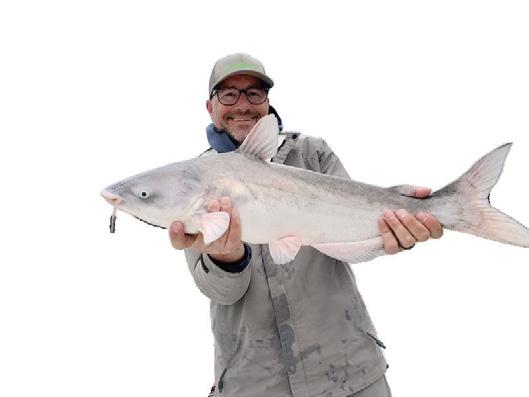
• Vertical high-resolution photos work best, with room for our logo header and cover lines.
• If the angler is a child is on a boat, make sure he or she is wearing a lifejacket (properly) in accordance with state boating regulations, or we won’t consider it for the cover.
• Once the submission period has ended, our graphic design team will disqualify any photos that do not meet our printing requirements (any images that are too low of a resolution, are blurry or too dark, if a child was pictured without a lifejacket, and if there was not enough room in the image for our FishTalk header, footer, and cover lines). We will then let you vote for the winning cover for the September issue of FishTalk Magazine!
Delaware
Pontoon Express | 302-945-0654 22572 Harbeson Rd, Harbeson, DE pontoonexpress.com
North Bay Marina Inc | 302-436-4211 36543 Lighthouse Rd, Selbyville, DE northbaymarina.com
Maryland
Annapolis Inflatables/Fawcett Boat Supplies 410-267-8681 | 919 Bay Ridge Rd, Annapolis, MD annapolisinflatables.net
Intercoastal Marine | 410-335-0458 2925 Eastern Blvd, Baltimore, MD intercoastalmarinemd.com
Scott’s Cove Marina | 410-784-7624 10551 Eldon Willing Rd, Chance, MD scottscovemarina.com

Hidden Harbour Marina | 301-261-9200 600 Cabana Blvd, Deale, MD hiddenharbour.net
Maryland Boat Sales | 410-574-3988 2426 Holly Neck Rd, Essex, MD mdboatsales.com
Powersports of Crofton | 410-697-5965 7045 State Route 3 North, Gambrils, MD hondaofcrofton.com
Galahad Marine | 410-827-7409 121 Rental Ln, Grasonville, MD galahadmarine.com
Danny’s Marine LLC | 410-228-0234 3559 Chateau Dr, E. New Market, MD dannysmarine.com
PYY Marine | 410-255-1771 1132 Pasadena Yacht Yard Rd, Pasadena, MD pyymarine.com
Thornes Marine | 410-957-4481 1237 Greenbackville Rd, Stockton, MD thornesmarine.com
Jett’s Marine, Inc. | 804-453-3611 18477 Northumberland Hwy, Reedville, VA jettsmarine.com
Friday’s Marine | 804-758-4131
(Malise Marine Sales & Service) 14879 GW Memorial Hwy, Saluda, VA facebook.com/fridaysmarine
Legasea Marine | 757-898-3000 821 Railway Rd, Yorktown, VA legaseamarine.com

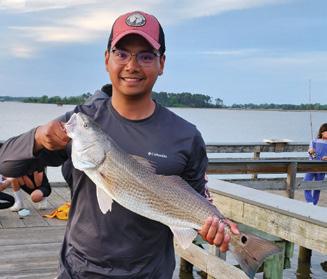


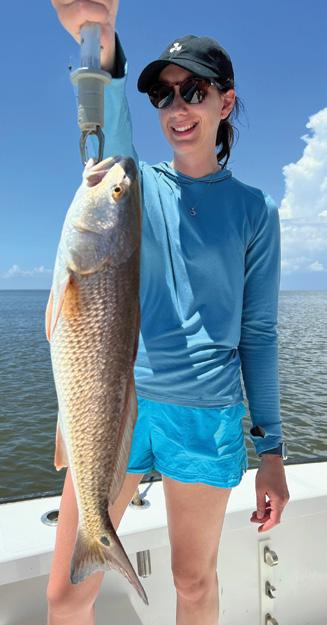
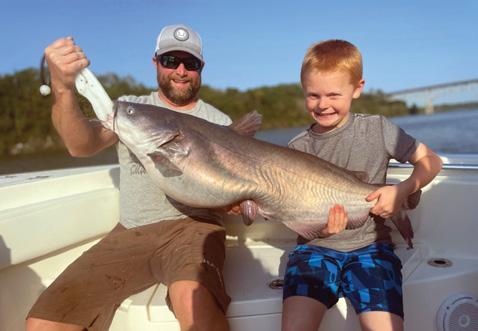

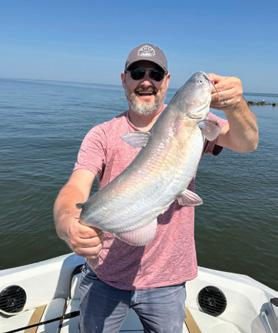

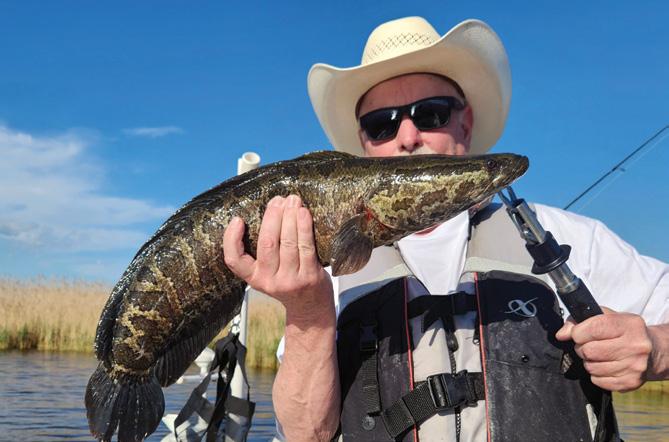

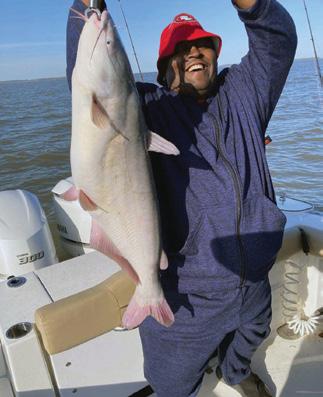






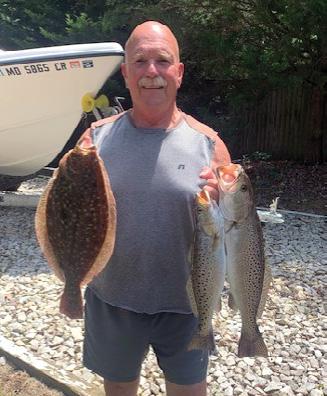


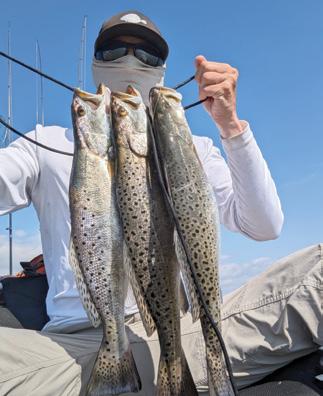
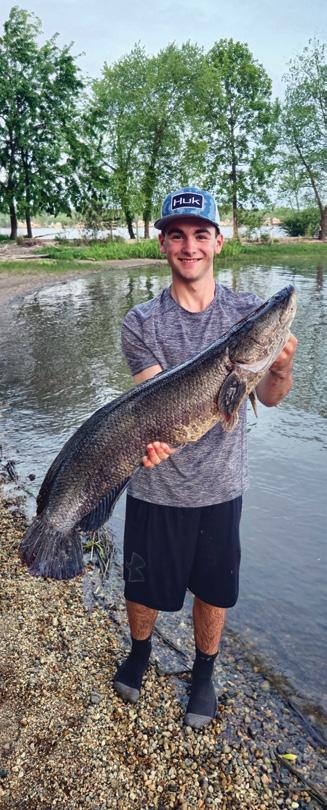
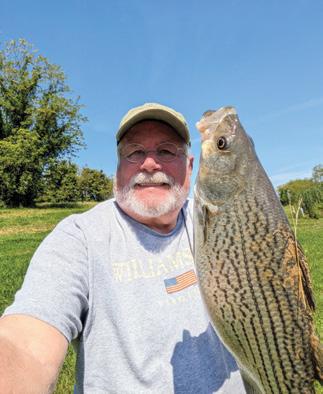
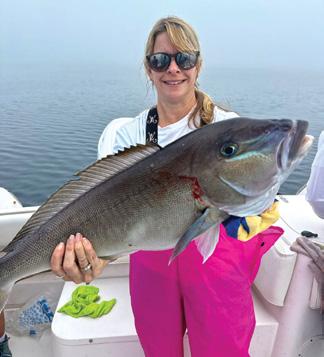
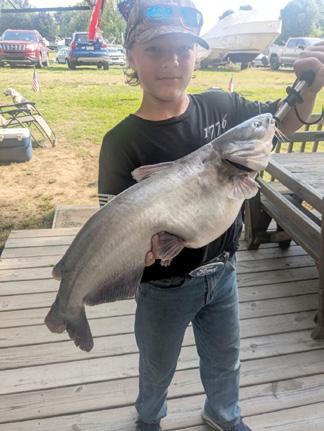
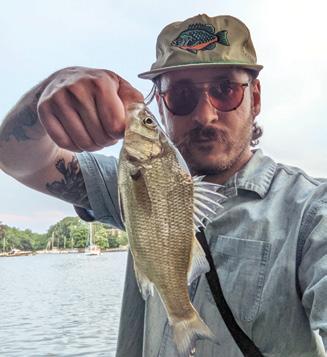




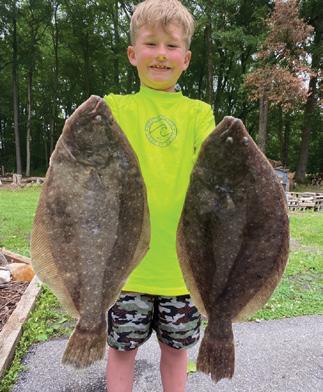



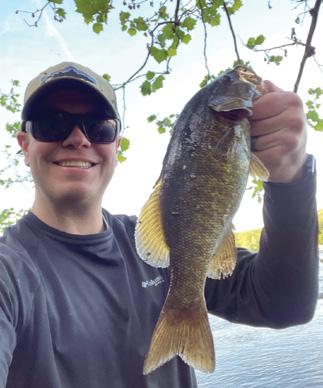

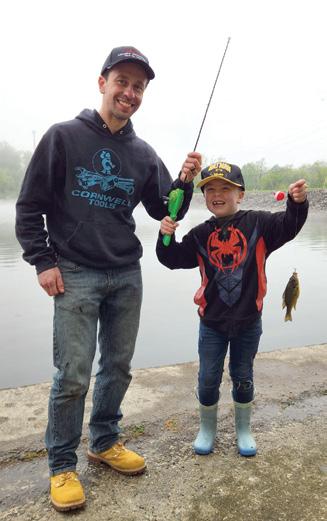


Editor’s note: Coincidentally both boats featured in this month’s Hot New Fishboats share a similar standout trait: shockingly rugged construction. We hate to sound like a broken record in these reviews, but if you step aboard either of these boats you’ll quickly understand why we’re emphasizing the same feature in both of them.
Back when I was an editor at Boating Magazine we got a new boat every summer for a seasonlong extended test and review. This boat would be run for thousands of miles through seas both small and absurdly large, fished offshore dozens of times, and at the end of the season I’d tally up all the things that broke, failed, or fractured. This went on for 10 years. The “damage list” ranged from six items to 18, and included everything from gelcoat cracks to an entire galley cabinetry unit that ripped off a bulkhead. There was one boat, however, that was built so rugged that the end-of-season damage list included just one meager item: a snap had pulled out of a nylon strap. That was it. The boat was an Albemarle 268. Flash forward two decades and I find myself testing another Albemarle, their 30 Express. I slam the hatches, kick the doors, and yank mercilessly on the pipework. And I’m overjoyed to find that today Albemarle builds their boats with the same rugged attitude as they did back then. There is, however, one
huge departure from the Albemarles of yesteryear. This is an outboard-powered fishing machine, carrying triple 300s on the transom. And while that 2004 vintage 268 had a tough time getting much north of 30 mph, the 2024 Albemarle 30 Express tops 60.
Performance is a serious highlight on this boat, and interestingly, speed matches up with rpm rather consistently through the powerband. Cruise at 3500 rpm, and you’ll be running along in the low- to mid-30s. Bump up to 4000 rpm and speed sits right at 40 mph. Take it to 4500 and you’ll run in the mid-40s. And at WOT we hit 60.2 mph. Also note that it leaps onto plane from a dead stop, which is rather amazing for a 13,000-pound boat.
Hard stop — a 13,000 pound 30-footer? Yup, that’s what happens when you build a boat this strong. That heft also means the 24-degree deep-V hull can mute the waves like no other, and as we blazed through a choppy Poquoson River it felt more like we were standing on the deck of an inboard battlewagon than on
a 60-mph outboard boat. It wasn’t until days later when someone commented on YouTube that I realized another illuminating detail: not one drop of spray had hit the windshield. Not. One. Drop.
Albemarle has always built offshorecapable fishboats, so it won’t surprise anyone to learn that the 30 Express is fully equipped for all sorts of angling.
The helmdeck houses tackle stations with
LOA: 33’6” Beam: 10’6”
Displacement: 13,000 lbs.
Draft: 2’2”
Transom Deadrise: 24 deg
Fuel Capacity: 320 gal.
Max Power : 900 hp
Legasea Marine, Yorktown, vA, (757) 898-3000 legaseamarine.com
five boxes and four drawers, the transom houses a 30-gallon livewell, there are 11 total rocket launchers lining the pipework, four flush-mounts in the gunwale, and there are 56-gallon fishboxes in the deck. In this case what really stood out to me, however, was that there are plenty of pipes to grab moving forward alongside
the cabin until you get to the bowrail, and a good amount of flush deck with no tripping points. That means walking up front and casting from the bow is a breeze, and this boat will perform better than most expresses of its size and nature when you have the urge to do some light tackle casting in the Bay.
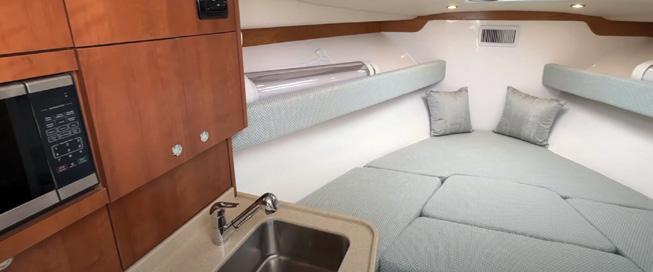
Though the fishing takes place abovedecks, the cabin on this boat merits some discussion as well. It boasts a galley with microwave, sink, refrigerator, and cabinets (that I’ll wager won’t rip free without the help of a chainsaw), a V-berth big enough for a couple of anglers to nap between bites on an overnighter, and a fully enclosed stand-up head. The head is the surprise here because Albemarle dedicated a lot of space to it, and it feels like the head on a significantly larger boat.
If you can’t stand the thought of flimsy parts, thin fiberglass, and swaying hard tops, jump aboard an Albemarle 30 Express. You’ll find that when it comes to construction quality they do build ‘em as good as they used to — just a whole lot faster.
S ee our video review of the Albemarle 30 Express at the FishTalk YouTube channel.
Some boats are built to skim through the waves and some are built to hop across them, but a rare few (these days) are built to squash waves underfoot like bugs. Let me share my Pair Customs story: The first time I was
aboard one of their boats, I was so impressed by how sturdy it was built that to demonstrate it on video, I decided to stand on the gunwale then jump down and slam my feet on the deck. It worked great so far as the video went,
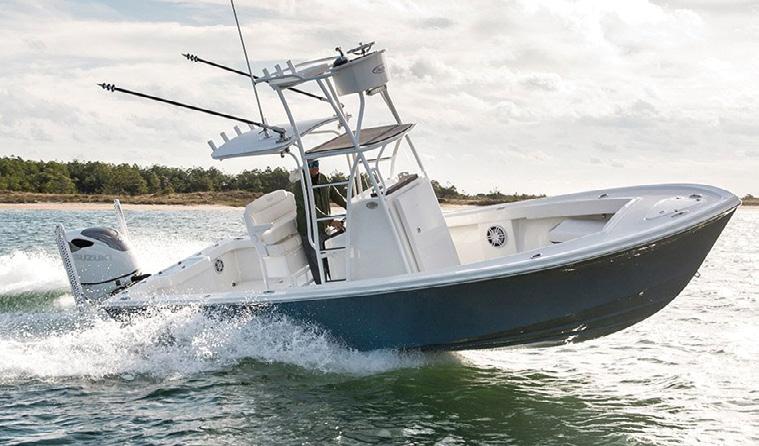
since it was obvious that nothing shuddered or vibrated one iota. Unfortunately, I also learned that jumping off the gunwale and slamming your feet down onto a rock-solid deck is, well, like doing it on a rock. Ouch. On the bright side, through my aching knees I did learn that without any doubt, Pair Customs are built like a brick you-know-what.
Cast off the lines and charge into a chop, and you’ll soon discover that their boat’s stout build shoves the waves right out of the way — and does so without the hollow drumming noise so many modern hulls produce. The key is the construction, which incudes two-inch-thick core in the stringers, biaxial 24-ounce fiberglass, and two-inch core in the transom sandwiched between layers of solid fiberglass. And on the Pair Customs 24 DV Center Console this transom is graced by a bracket, so the outboard is moved far aft to provide an improved center of gravity. That helps smooth out the ride even more,





# You’ve gotta love a good integrated tackle station, something that’s MIA on many 24 foot center consoles.
while also maintaining maximum fishing space in the cockpit. In fact, note that although this boat is called a “24” that’s a hull-only number; LOA is actually over 27’.
This is a hard-core fishboat, with a full complement of armaments. There are four standard-issue flushmount rodholders in the gunwales with the option to add plenty more, four rocket launchers in the leaning post, and five rocket launchers in the outrigger-ready top plus two kingfish holders. The back of the post has a tackle station with four Planos and two drawers. There are three fishboxes in all, one forward and two in the deck, and the transom has a centered livewell. Fuel capacity is bodacious, too, at 150 gallons, so cruising out to bluewater will be well within this boat’s capabilities.
Drop a Suzuki DF300 on the transom and performance is eyeopening with a top-end busting right past the 50-mph mark. Throttled back to 4500 rpm you’ll be cruising in the mid- to upper-30s while getting

around 3.5 mpg. And if you can stand to run at a more relaxed pace of 3500 rpm in the upper 20s, the 24 DV gets an eyebrow-raising 4.3 mpg. Built as tough as they come? Check. One hundred percent fishability? Check, again. Awesome performance? Triple check. But if you feel the temptation to take a Pair Customs 24 DV Center Console for a sea trial, don’t jump down and slam your feet on the deck — that’s a battle the boat’s going to win.
LOA: 27’4”
Beam: 8’6”
Displacement: 4300 lbs.
Draft: 1’8”
Transom Deadrise: 22 deg
Fuel Capacity: 150 gal.
Max Power : 300 hp
Brown Dog Marine, Trappe, MD, (410) 310-8931 or browndogmarine.com



There are many ways to connect your boat with the IoT, but those thirdparty systems exclude your boat’s engine from the conversation. At least, they all did up until now. Siren Marine, which is owned by Yamaha, has announced outboard integration with Siren systems via the new Siren app for 2024. The trick was teaching Siren to “talk” in Yamaha’s Command Link protocol, and now that it can do so Siren can communicate with your outboards and beam alerts to your phone for data like scheduled maintenance. It can communicate with digital rigging and steering systems and maintain records for your engine. And if you so choose, it can send that intel right to your dealer, too.
On top of these new abilities the Siren system continues to provide the 24/7 monitoring it has in the past, with geofencing functions, alarms for critical items like high bilge water or low battery charge, and the ability to add security sensors like motion detectors that can trigger lights or alarms. And if your boat has CZone digital switching (or you add DC accessory relays) you can also use Siren to remotely control your boat’s systems and pull off nifty tricks like turning on the air conditioning or turning off the lights while you’re sitting at home on the couch.
You say having a connected boat would give you some peace of mind? Check out the Siren app in demo mode, or visit sirenmarine.com to find out more.






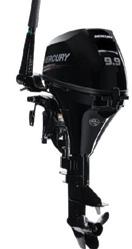


When tuna are up top but ignoring your trolled baits, it's time to shift gears.By Lenny Rudow
Acres of yellowfin tuna are busting water all around us at Poormans Canyon, there are five boats trolling through the frenzy, and all of our baits are going unmolested. For half an hour we zig and zag, try different offerings, and peek at the other boats with binoculars trying to see who’s unlocked the code and if so, what’s on the end of their line. But zero bent rods are spotted.
This. Is. Pure. Torture.
Then a school of baitfish surfaces alongside the bow and we see that they’re much smaller than one would have guessed, just four or so inches long. “I need a little topwater plug,” Max shouts out. He rifles through the tackle station, finds a 3.5” Badonk-A-Donk, ties it onto a 20-class spinning rod used for bailing mahi, and flings it out. Three twitches later a tunanuclear explosion erupts. The poor little 4500 Baitrunner attached to the rod shrieks for a second or two, then the line goes limp and Max reels in the eye of the plug with a chip of plastic attached. We’re going to need a tougher plug.
We ditch all the trolling gear and try chugging a seven-inch Chug Norris and popping an eight-inch pencil popper, but to no avail. Evidently, size matters — a lot. Then we find a four-inch MirrOLure Top Dog in the box and decide to give it a try. Seconds after it hits the water it disappears in a violent eruption, and the battle is on. It takes well over an hour to coax the fish up to the boat on the relative peashooter of a rod and reel, but eventually Brian sinks the gaff into 65 pounds of yummy and swings the kicking fish over the side of the FishTalker.
First, full disclosure: I make no claim to being any sort of expert at catching tuna on topwater. In fact, from 1998 through 2008 I had a boat at the O.C. Fishing Center, fished offshore almost exclusively from June through September, and never
had a problem trolling up strikes when tuna were at the surface. There was never a need to try throwing a topwater plug at them and it never even occurred to me to do so. After this experience, however, I spoke with several people who spend far more time on the ocean than I do these days, and they confirmed seeing the same scenario multiple times in recent years.
Strangely, this jibes with changes in the West Coast tunasperience. Those who follow tuna fishing off California will know that a decade or so ago “regular” trolling became less and less effective and skipping kite baits turned into
the hot thing. It later shifted to “foaming,” run-and-gun fishing looking for tuna busting on the surface, then casting surface lures into the frenzy. Or, when the fish act boat-shy, by pulling the plugs way back and circling the periphery of the fish until it’s possible to shift into neutral and retrieve the lure through the school.
Any way you look at it and anywhere you go, the hot tactics and tackle can and do evolve and change as the fish’s feeding patterns change over time. Different food sources and different habitats become more or less attractive or available, and the predators change their ways in response.

Or, maybe the fish just get smarter. Whatever. Let’s all just cross our fingers and hope that this tuna on topwater thing is a trend that continues, because seeing a yellowfin obliterate a topwater lure will give you a shot of adrenaline akin to bungee jumping or skydiving. Nah, it’s way more potent!
Since we were not expecting to throw plugs at tuna, we most definitely did not have the appropriate gear. Hence, Max reeled in the “Ba” absent the remaining “Donk-A-Donk.” To be even remotely prepared for this action you’ll need to carry plugs that are constructed to survive an attacking yellowfin followed by 15- or 20-plus pounds of drag pressure. The MirrOLure pulled through in part because we kept a light drag on a 20-pound-class rig. And it just barely made it; one hook was broken off and the other was bent. Fortunately, in part due to the rise in West Coast topwater tuna action, several lure manufacturers have developed lines of plugs specifically intended to survive the pulling power of a tow truck. Nomad Tackle, Hogy, and Rapala, for example, all make topwaters with expanded high-density ABS plastic, through-wire rigging to the hooks and eyes, and 4X to 5X hooks. They range in size from small versions barely over three inches long to big 10-inch belaying pins. And, as our experience validated, you need a wide range of sizes because there can be times when plugs failing to match the hatch will be completely ignored. Note that you’ll also want a selection of both chuggers and walkers, as the different presentations they provide can produce radically different results in any topwater fishery.
One of the sharpies we spoke with suggested having no more than two rigs in action at any given time. With tuna on spinning gear being fought from a static boat, dealing with multiple hook-ups and keeping the lines clear is much more difficult than it is when trolling with heavy conventional tackle.

# Nomad, Rapala, and Hogy all make tuna-specific plugs that can stand up to heavy-duty punishment.
As for rods and reels, mahi gear doesn’t cut the mustard. You can get lucky and land a tuna using 20-pound gear and seven pounds of drag but you’ll be unlucky as often as not. Pushing up to 30-pound gear and 10 pounds of drag should be considered absolutely minimal, and ideally, you’ll want to sling a rig large enough to handle 40-pound braid and 20-plus pounds of drag. (Note: you’ll still want to set drag pressure for about a third of the line’s pound-test, but the drag systems in many reels that are rated for less than 20 pounds of force are of a lower quality and won’t live through the burning runs of large yellowfin).
The sharpies I spoke with said that since your offering is on the move as opposed to sitting more or less still, such as with chunking, you can beef up the leader and they’ll still take the plug without hesitation. On the flip side of the equation the fish rarely get the plug all the way down the gullet so leader chafe usually isn’t a big problem. Bottom line, 50- to 60-pound fluoro works fine.
The toughest part of this game, of course, is finding busting yellowfin in the first place. Heading offshore with this as your game plan would be pure folly. Instead, head offshore prepared to troll or chunk as you always would. Keep an eye on the horizon for surface action and/or birds, and if you spot a frenzy but trolled lines go biteless, crank them in and grab the rigs you have ready for tuna on topwater. Start chugging, popping, and walking. And get ready for a shot of adrenaline that can’t be matched — even by jumping out of an airplane.
We weren’t able to locate anyone around here who’s tried it, but in California when foaming fish hesitate to hit plugs anglers will often fling jigging spoons like the Shimano Current Sniper or the Aftco Blue Fever Crossbreed, which fly a mile and will sail out farther from the boat than a plug. These are generally given a few seconds of sink-time, then burned back to the boat at top speed. #
The famed Winter Quarter Shoal has a number of elements that go along with its reputation as an excellent hotspot for both fishers and divers. There are a few very small anomalies under the fish haven circle highlighted by the yellow circle in Chart 1. These are probably the remains of 60 junked auto bodies that were deposited at the fish haven in 1959. NOAA’s database also states that permission to dump material at the reef site was granted by the Baltimore District, U.S. Army Corps of Engineers, to the Coast Guard Auxiliary in Chincoteague. If the dates are correct, then this could be the oldest fish haven in Virginia waters.
Other than the shoal itself, which is substantial, the primary artificial structure at Winter Quarter are two wrecks. The larger wreck is the barge Barnstable It sank as the result of a marine casualty and was reported in a 1934 Notice to Mariners. The wreck is very deteriorated, but still has considerable mass spread out across the bottom which is great for
attracting flounder and other species. The charted wreck southwest of the shoal is listed as unidentified. It’s about 150’ long and appears mostly buried. There are several objects under an obstruction circle on the east side of the shoal as well, as shown by the lower right Chart 2 inset.
One and a half miles southeast of the shoal lies the broken remains of the bulk cargo ship David Atwater, a U-Boat legacy wreck. The ship was loaded with a cargo of coal when it was attacked by gunfire during early morning hours in 1942 by U-552. U-Boats were brazen in their attacks during the early stage of the war. The sub fired 93 rounds from its deck gun, hitting the ship 50 times. The bulk carrier was set afire and sank with the loss of 24 men. Although the hulk is demolished, there is still a substantial mass on the bottom that provides marine habitat.
Working southeast from Winter Quarter Shoal, there are some very prominent wrecks that are popular diving sites and frequently appear in fishing reports. Wreck locations, circled in red, are shown
on Chart 2. Coordinates are published by various websites. However, each is under an obstruction circle as are most of the other wrecks discussed previously. Just steer for the circle on your chartplotter, or pick out the circle coordinates on an electronic chart and enter them as waypoints.
The fishing vessel Atlantic Mist has a steel hull and is 75’ long. It was recorded in 1982. The hulk locally known as the “Middle Ground Wreck” is what’s left of an unidentified wooden sailing vessel. It was recorded in 1984 and at the time, the vessel was partly intact and the bow rose 10’ to 15’ above the bottom. The BDV image shows the remains in a scour hole and suggests that the vessel is largely covered with sediment. The unidentified wreck known locally as “The Sub” is broken up and distributed on the bottom. The records have no information about the additional unidentified wreck shown on the chart. As displayed by the Bathymetric Data Viewer (BVD) image, the wreck is broken up into three sections, the center section being the largest. However,
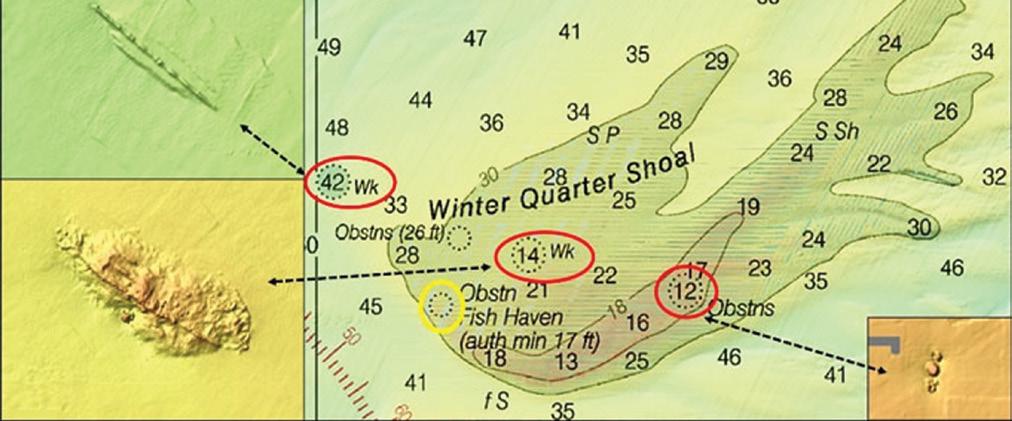
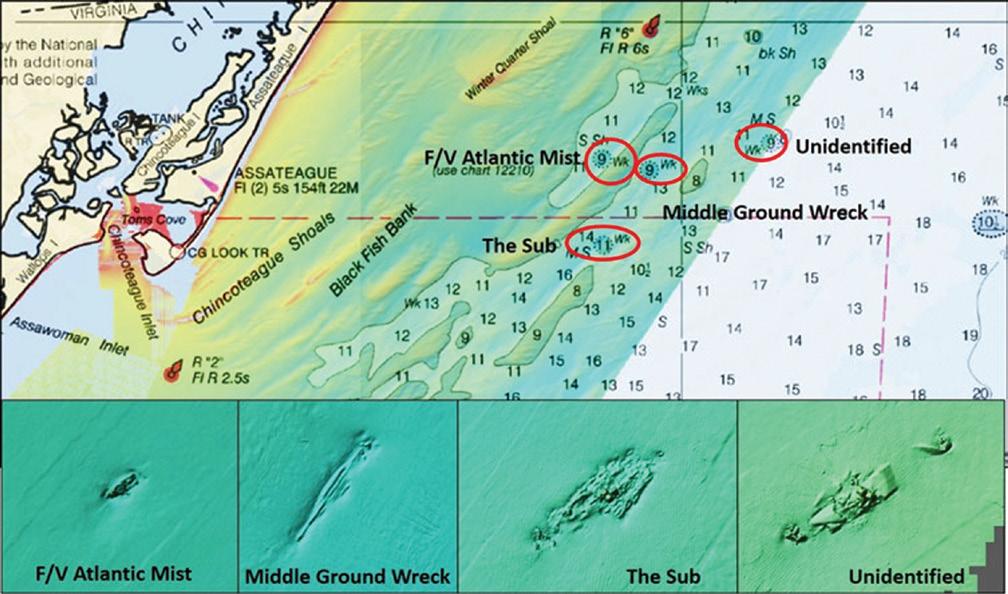
it appears to be quite substantial and using the BDV embedded distance scale, the main body of the wreck is about 200’ long.
Next is the “Bone Wreck,” sometimes referred to as the USS Bone, but there never was a Navy ship with this name. The wreck is actually an unidentified vessel with a metal hull. A NOAA diver inspection circa 1981 was unable to
determine the name on the hull due to extensive coral growth. The inspection found a 70’ scour hole on the east side. However, conditions have changed substantially over the past four decades. When the BDV image was taken, probably in the last 10 to 15 years, the hull was largely broken up. This is a popular dive site, and there are diver videos of it on the internet.
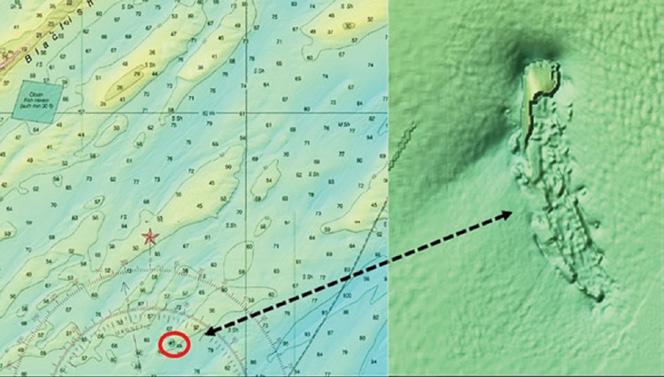
There are more wrecks further offshore that are outside of BDV side-scan sonar-like coverage. One is the 605’ long Marine Electric which sank in the location shown on Chart 3. This ship was a World War II tanker that had been converted to a bulk carrier with pilothouse aft. The ship was loaded with coal when it was caught in a storm and broke apart due to structural issues. There are two main sections and scattered debris. The wreck is a popular dive site, and there are diver videos on the internet — it holds a lot of fish.
Armed with all of this information and current fishing reports, haul on over and launch the boat. We’re on our way to some exciting fishing opportunities off the coast of Chincoteague!
As well as being a regular contributor to FishTalk, Wayne Young is the author of multiple books detailing wrecks and fishing reefs in the Chesapeake Bay, Delaware Bay, and beyond. All are available at Amazon.com, and you can find his Facebook page at “Chesapeake Bay Fishing Reefs.”
you don’t need to master fly fishing to enjoy awesome trout action.
Step aside, fly guys. Conventional fishermen can experience the thrill and beauty of brown trout, too. Catching browns on spinning gear is not complicated, but it requires an understanding of the gear you’ll need, how to read a stream, and the proper approach, casting, and retrieval techniques to catch these colorful fish.
When fishing for brown trout in our local streams, you’ll often be in tight quarters, surrounded by trees and other foliage on the bank. You’ll also be throwing small and lightweight inline spinners (more on this later). So, a 4’8” to 5’0” ultralight rod is the way to go. The shorter length will give you the ability to swing that thing over, under, or around brush without getting snagged on your back-cast. In terms of rod action, go with fast or extra fast. You’ll want to be able to detect every little nibble.
An effective spinning reel for skinny water browns is one that has a higher gear ratio and is lightweight enough to make precision casts. You’ll want the blade of your spinner whipping and flashing as you retrieve it with the flowing current. Use too slow of a reel, and either your lure will just drift as a limp piece of metal with no action, or you’ll wear your arm out trying to crank fast enough to give it action. Accurate casting is also key, as errant casts will often lead to snags on the other bank or in a
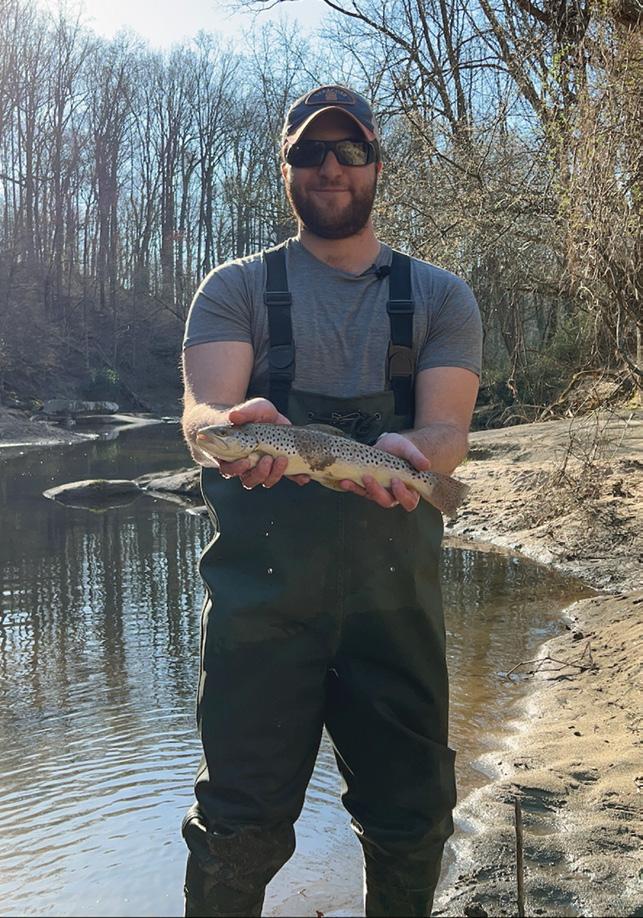
piece of structure you’re working. All of that being said, grab yourself a 1000 or 1500 size reel with a 6.2:1 or higher gear ratio.
Lightweight and low visibility line is another must. Small inline spinners need light monofilament to maximize their potential. Heavier line will decrease your casting distance and hinder the action of your lure. Remember the importance of sensitivity in your setup, and that using lighter line twill also increase your ability to feel strikes. Brown trout have extremely sharp eyesight and get spooked easily, so choosing clear color line will get you way more bites. Go ahead and spool up with four- to six-pound test.
Now that our rod and reel combo is locked and loaded, it’s time to pick out some lures. Inline spinners are pretty
much all you need to catch brown trout in streams. The mix of flash and vibration imitates the plethora of prey that trout consume. Different colors and patterns excel in certain conditions more than others, so make sure to get a good variety. Typically, gold blades do better in low light conditions or in stained water. Silver blades excel in bright sun and clear water. For the spinner body, go with brighter colors like orange, yellow, or red in muddy streams, and natural colors like brown, black, or white in cleaner conditions.
If you’ve never fished a narrow stream and show up expecting to work it like a lake or the Bay, you’re in for a frustrating outing. Hunting brown trout
in small streams is finesse fishing at its finest; every detail matters if you expect to land a big one. Read a stream like you read a good book. Get excited by the twists and turns, the structure, the flow.
Areas where the stream turns a corner are ideal ambush spots for trout. The current usually slows around a bend, and all the bugs and baitfish that are drifting through the water slow down with it. This gives the trout an easier opportunity for a meal. Furthermore, the outside of a bend will often form a cut bank due to erosion, giving the trout a place to stay hidden until they spot prey.
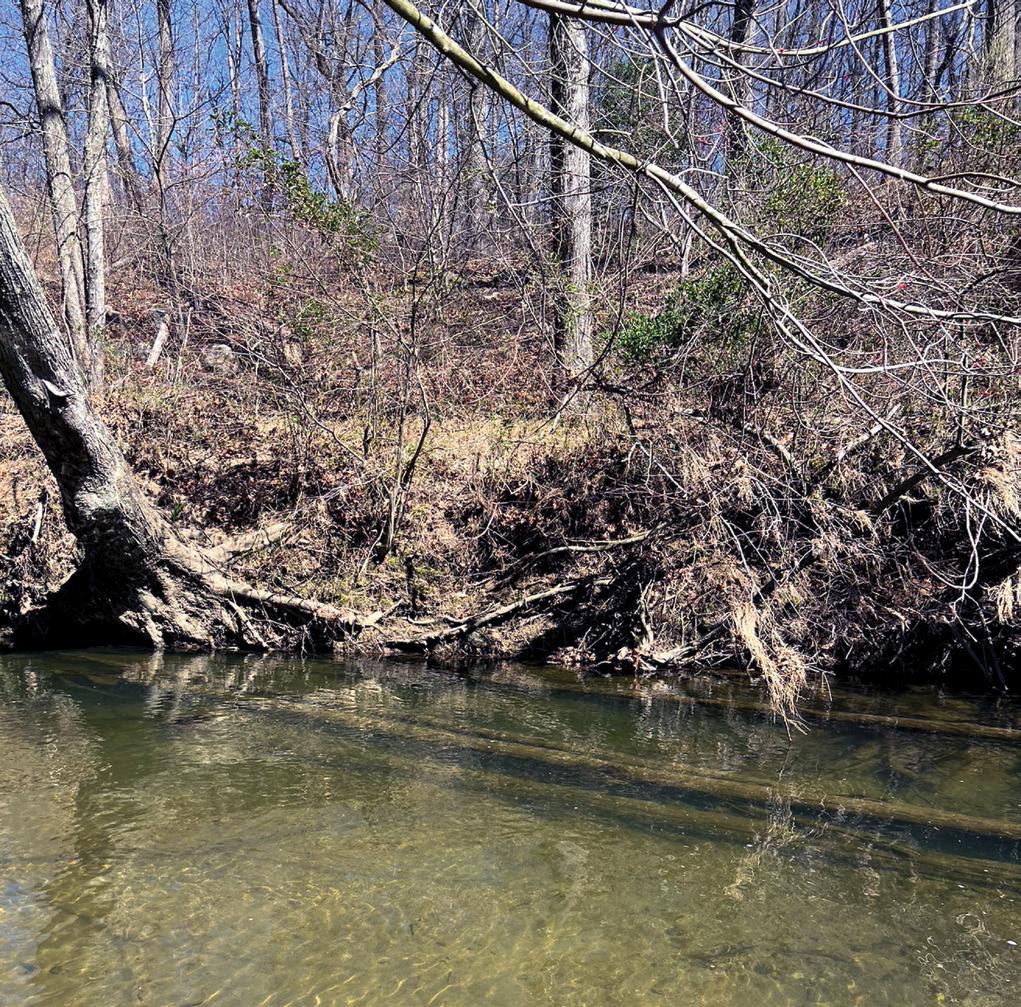
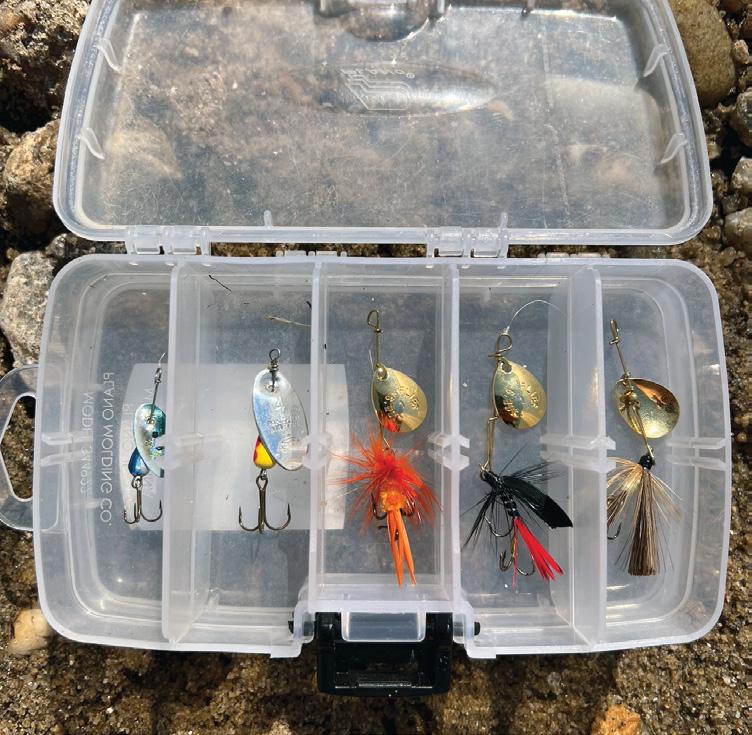 # Make sure to get a variety of inline spinners in order to be well equipped for changing conditions.
# Laydowns like this one provide hiding spots and ambush points for trout.
# Make sure to get a variety of inline spinners in order to be well equipped for changing conditions.
# Laydowns like this one provide hiding spots and ambush points for trout.
Hard structure is another key feature when deciding where to cast in a stream. Imagine yourself as a trout. Where in the water would you hide to ambush a meal? Fallen trees, dams, and boulders all provide cover and points of attack for fish. Casting in and around these natural blinds for a brown on the hunt will frequently result in a strike.
Finally, you’ve got to go with the flow. Areas where the current goes from fast to slow or vice versa are also brown trout hotspots in a stream. These areas typically consist of rapids leading into a slow, deep pool (or the other way around). Especially in the colder months, it is essential to find these areas. A brown trout’s metabolic rate decreases in the winter, so it looks to find warmer water and expend as little energy as possible. Deep pools hold warmth, and the slower current allows the fish to maintain its position without working too hard. Rather than chasing prey down a fast flow, he’ll prefer to not work as hard and wait for a meal to slowly drift by.
Finally, we’ve made it to the stream, ready to hunt for a juicy bend, bit of structure, or change in current and depth. Another puzzle now presents itself. Should you head upstream or downstream? Remember, stealth is key for skinny water trout, so if you’re getting in the water to wade, always walk upstream. You’ll stir up mud and silt with each step, and if you were to move downstream, you’d be following this dirtied water much to the fish’s advantage and to your detriment. They’ll know you’re coming well before you approach their position. If you plan to walk the bank there is a little more leeway for heading downstream, but it is still less ideal than traveling upstream. You won’t be stirring up debris, however your shadow may pass over a fish and spook him before reaching your point of attack. Plus, fish generally sit facing the current so they’ll be looking in the direction you’re coming from and could spot your movement.
Go ahead and position yourself downstream of the target you plan to cast at. Now, let’s pick it apart. Toss out your lure so that it lands above the structure, bend, or current change you’re working, and retrieve it back downstream towards
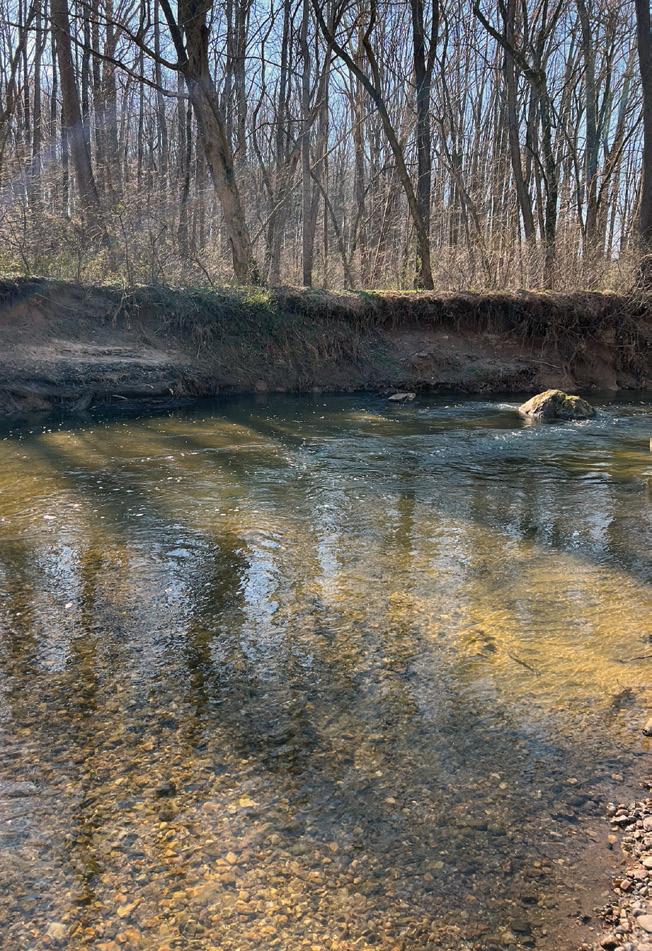
you. In the colder months, reel just fast enough to get the metal blades turning. If the weather is warmer, feel free to rip it a little faster. Always stay tight to your spinner. Allowing the slightest amount of slack in your line will cause the lure to drift limp. Never cast downstream and retrieve back up towards you. Trout face upstream waiting to ambush prey drifting down. So, a spinner moving opposite the direction that the stream is flowing is an unnatural presentation and will likely be ignored by fish.
Try to keep your lure in the outside of a bend where the deeper water or cut bank will be. For structure, bring your lure as close to it as possible. Don’t be afraid of getting hung up — you might lose a lure, but you could also miss out on a fish lurking within a dam or lay-
down waiting to ambush your offering. If you’ve found a slow flowing, deep pool either above or below some rapids, cast upstream and retrieve your lure through the transition zone from fast to slow (or slow to fast) all the way back to where you’ve set up downstream.
One final word of advice: follow the foam. Foam lines in a stream give an indication of where the current is collecting debris, including trout food. Fish will often be staged close to these lines, so retrieving your spinner along them would be wise.
Walking a stream for brown trout can be incredibly peaceful, therapeutic, and rewarding. Employ these tactics and experience the beauty and majesty of brown trout for yourself, with your spinning gear in hand.
These c R azy, T oo T hy, snake-like c R i TT e R s a R e cool!By Lenny Rudow
Cutlassfish, AKA ribbonfish, AKA hair-tail, seem to be on a serious tear. Once they were an occasional oceanic catch, then they invaded portions of the southern Chesapeake in big numbers, and last season they expanded their rule clear up into the Middle Bay — we even had one reader check in with a cutlassfish catch from all the way up in Curtis Creek. And during the month of August a school so massive it was possible to catch dozens per hour (we counted 62 in three hours of fishing one afternoon) parked itself off the mouths of the South and West rivers.
Okay, so there can be a lot of them around. Why should we care? Because although they may look downright zany, these fish offer a unique fight and great eating. Cutlassfish can swim backwards, so they can tug quite a bit on the end of the line. Then when they stop tugging they have almost zero resistance as they’re pulled through the water, so often you think they’ve pulled free. But keep reeling and no, wait! There they are again, tugging and yanking.
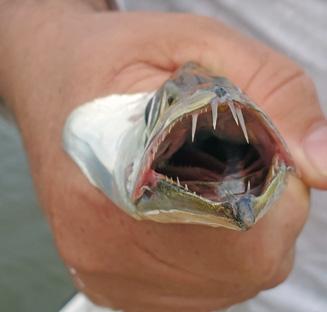
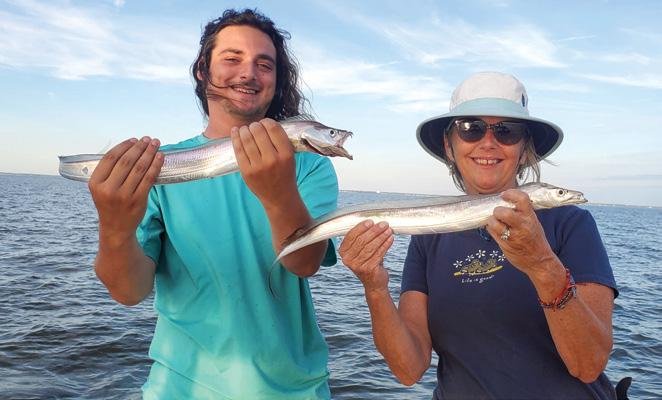
Drop a few into the cooler, take them home, and you can slice away a long, thin fillet from either side of the fish. Try eating them, and you’ll quickly understand why this species is considered a delicacy in many parts of the world and can cost four to five times as much as the average fish in some Asian fish markets. The meat is firm, white, flaky, and somewhat similar to flounder in nature.
Ribbonfish do play the tide, and at times will turn up their strangely shaped noses no matter what you may present them with. Like most fish, however, they tend to bite well when the current’s running, late in the tidal cycle, early in the morning, and late in the afternoon. In the Bay and its tribs they tend to hover around low in the water column
In the Bay and lower portions of the tribs, when you’re hunting for cutlassfish keep an eye out for osprey. They love eating cutlassfish, too, and often you’ll spot them flying back to land clutching the long, silvery fish. Look in the direction they came from, and if you spot three to five other osprey circling way above the water in the area, you know exactly where to head.
in 10 to 25 feet of water but at times will come up to the surface and chase bait — it’s not uncommon to see their long, silvery bodies launch out of the water and grayhound much like a Spanish mackerel or a houndfish.
You can catch a cutlass casting and retrieving just about any lure in the two- to five-inch range (larger ones may be in order for bigger specimens found in the ocean), though they need to be of the bite-proof variety or you’ll reel in one tail-less bait after the next.
These fish have some serious teeth and have zero problem biting through standard-issue soft plastics. In fact, when you bring one into the boat be sure to take care to keep your fingers and toes away from those snapping jaws.
When you spot cutlassfish on the surface or on your meter, or locate a school via trolling and then stop, casting to them is tremendous fun. Most of the time, however, the killer tactic to use for catching cutlassfish is light tackle trolling.

Towing your offerings on light tackle behind a boat at just two or three mph is deadly on these fish. Stock rockfish jigging rods and reels works great, and any light to medium action 6’0” to 7’0” rod rigged with 15-pound braid or thereabouts, plus a few feet of 20-pound fluoro leader, will get the job done. Simply pick your course, make a long cast off to either side and close the bail, and set a third line down the middle.
You can troll bite-proof plastics on leadheads or pull small spoons, but lipless
Note that these fish have an odd appearance on many fishfinders and sometimes show up as sketchy light blue or green horizontal lines or Vs as opposed to creating hard arches. When the tide is completely dead you may see those green and blue streaks and Vs on your meter, hovering deep, just a few feet off bottom. In these conditions trolling plugs becomes much less productive. However, it’s possible to generate a few bites by casting out small Castmaster and Hopkins spoons or threeinch bite-proof paddletails, then working them slowly and steadily just off bottom. In this scenario, rather than hard strikes the hits come as added weight and feel almost as though you’ve hooked a clump of seaweed. So when you feel any additional weight in this situation, set the hook.
# Cutlassfish are suckers for swimming plugs like Rat-L-Traps.diving plugs like Rat-L-Traps in the one-half to threequarter-ounce size will utterly decimate these fish. These lures can be trolled directly from the rod tip with no additional weight or hardware, and the steady thrumming of your rod tip lets you know that it’s swimming properly; if that thrumming ever stops be sure to reel up and check for snagged weeds or a fouled line. A spread with a swimming plug on either side and a spoon set a bit farther back down the center will minimize tangles.
These fish do change color preferences from time to time but the blue/chrome Rat-L-Trap and the Strike King Red Eyed Shad Tungston 2 Tap in the Natural Shad shade proved to be epic producers last season. As for spoons, again natural colors work well but at times gold seems to generate bites when other colors don’t.
Another highly effective way to troll for cutlassfish is to set a stock-and-trade Spanish mackerel spread with #1 and #2 planers, using the exact same small spoons that entice those mackerel. The downside is that you’ll be cranking back the fish with significantly heavier gear, and because cutlassfish strike and miss quite often, you’ll need to keep an eye out for tripped planers.
These fish may be relative newcomers to much of the Bay’s waters, it’s true that they’re just about the zaniestlooking fish that’s started swimming our way in the recent past, and we can’t guarantee that they’ll return to our waters in as vast numbers as they have in recent years. But if the reports say that cutlassfish are around, this is a target worth aiming for. The first time you reel one up it’ll trigger some giggling, and the first time you swallow one down it’ll trigger some grinning — and we guarantee you’ll be glad that these strange visitors came to town. #
Though these are mostly open-water fish, boatless anglers who want to get in on this action aren’t entirely out of luck. The king of all land-based hotspots for ribbonfish is undoubtedly casting from the shore near the Lesner Bridge in Lynnhaven. Casting Sea Striker Gotcha plugs is a local favorite tactic. In Maryland waters we’ve heard of them being caught while casting from piers at Solomons, and from shore in the Tangier Sound. We also had word of one caught from the Matapeake pier last year by an angler casting a bottom rig baited with a small chunk of spot.
Are you rapturous over ribbonfish? Craving the cutlass? Hoping to tear into the hairtails? We thought so. When you catch some remember that the skin of a cutlassfish is delicate, free of scales, and virtually imperceptible when eaten. So, there’s no need to worry about skinning these fillets — just slice the meat from the bones and you’re ready to start prepping a meal like one of these:
• Sushi rice
• Cutlassfish fillets
• Sea salt
• Soy sauce
• Wasabi
Put the sushi rice in the cooker, and slice fillets into two-to three-inch sushi-sized pieces. Run a fillet knife across the skin side of the fillets to create a series of cuts no deeper than the skin itself. Then place the fillets on a small-mesh grilling grate or in a grilling basket, give them a sprinkle of sea salt, and grill over high flame for one minute on each side. Form the rice into balls and top each with the grilled fish; season with soy sauce and wasabi to taste.
• Cutlassfish fillets
• Crab imperial
• Imperial topping
• Old Bay
Lay out the cutlassfish fillets skin-side-down. Slather a thin layer of crab imperial along the entire fillet. Then roll the fillet into a pinwheel. Place the pinwheel onto a cooking sheet and bake at 350-degrees for 15 minutes; top with Imperial topping and continue baking until it begins to brown on top (about five minutes). Remove from the oven, sprinkle with Old Bay, and enjoy.

# This plate of cutlassfish pinwheels won’t be around for very long at all once it hits the table.
#

Some new propellers could have you feeling a little loopy.
By Lenny RudowWe all want to make our fishing boats better, but the vast majority of the things we do amount to nibbling around the edges. We add a rodholder here and a cupholder there, replace a few cushions, and if we’re feeling really ambitious maybe mount a set of trim tabs where none sat before. But if you want to see a significant performance upgrade you’ll need to get radical and replace the powerplant or maybe just get a new boat.
What if I told you that you could radically boost your midrange rpm cruising speed, reduce your fuel burn, and make your boat more pleasant to be on all at the same time?
We’ve been hearing about these new propellers made by Sharrow Marine, which have loops instead of blades. The idea is to attack cavitation, the efficiency-robbing effect that forms at the tips of all propeller blades and results in that monstrous stream of whitewater behind your boat. Where did all those bubbles come from? The prop is well below the waterline and if it were sucking in air from above would lose its bite, yet even at slow speeds when you look behind the transom you see torrents of aerated whitewash. The reason is pressure fluctuations which allow dissolved gas in the water to diffuse into bubbles (a process called “rectified diffusion,” for you tech geeks), as vortices whirl off the blade tips and cause atmospheric chaos.
The process is often compared to the way bubbles boil out of water when the temperature is high enough. Well, have you ever noticed that a boiling pot shakes, rattles, and makes plenty of noise? So does a cavitating prop. Net result? Your boat’s performance isn’t as strong as it could be, and as an added bonus, you get subjected to vibrations and noise. Yay.
The Sharrow attacks this problem by eliminating propeller blade tips altogether. Instead of traditional blades it generates its thrust with loops, which arc from the front of the prop’s outer hub to the back. The concept is so completely novel that the Sharrow MX was named one of TIME’s Best Innovations of the year and has won a slew of awards including a National Marine Manufacturers Association (NMMA) Innovation Award.
Full disclosure: I was one of the judges on that NMMA panel, Sharrow is a FishTalk supporter (thanks folks!), and so far I’ve had just one on-thewater Sharrow experience. But it was an extended one, where we ran a 30’ center console with the stock manufacturer propellers and then took it back to the dock, swapped them out for Sharrow props, and ran the boat again. The experience was illuminating. At 3000

rpm with stock props the boat was still in pre-plane mode, with its stern squatting and the sky-high bow pushing water at 14 mph. With the Sharrows spinning at 3000 rpm we ran at 24 mph, and efficiency leapt from 0.9 mpg to 1.4 mpg. As speeds increase the advantage shrinks a bit but remains substantial; at 4000 rpm the Sharrows maintained a fourmph edge, and at faster speeds hovered right around three mph.
This shakes out to an efficiency boost of around 60 percent at a slow 3500 rpm cruise and seven percent at a fast 4500 rpm cruise. Those are pretty compelling numbers, but they don’t tell the complete story. First, we need to note that different hulls and different power packages will see different results. Multiple engine rigs will obviously see the most dramatic improvements, since they’re spinning multiple propellers. Second, these propellers cost significantly more than regular stainless-steel props because each is custom-honed (to one to two thousandths of an inch tolerance) to fit the specific boat/power combination.
Just how long it will take to recoup the cost via fuel savings will, of course, depend on just how much fuel you burn through the course of a season — though we’ve got to point out that at current fuel prices, if you have a 200-gallon tank that needs regular filling it certainly won’t take eons. And then, there’s the rest of the story…
Could these things actually help you catch more fish? As of today we can’t answer that question. What we can say for sure is that getting rid of all those whirling vortices and exploding bubbles dramatically reduces noise and vibration aboard the boat. So much, in fact, that standing aboard the deck of that 30-footer the smoother, quieter ride was for me, personally, more impactful than the efficiency boost. And as we all know, noise scares fish. Would swinging a set of Sharrows mean you could approach a school of breaking rock without freaking out the fish? Could you idle through the shallows without spooking the specks? We don’t know, but we hope to find out soon — stay tuned. #
When on the market for a new reel it’s easy to get lost in the endless sea of options.
With so many companies building fishing reels, all of which have their own models, size charts, and fancy lingo for the newest and most hi-tech features, it’s no wonder why you could spend hours staring at the big glass display case in your favorite tackle store pondering. Before diving into what the best size and type of reel for your style of fishing is, let’s cover the basic categories and dissect what the different specs mean. There are two main types of reels including those with fixed spools and those with revolving spools, which can be further broken down into four types. Fixed spool reels include spincast and spinning (which take up line by laying it on the spool), and revolving spool reels include baitcasting and conventional reels (which take up line by turning the spool itself). All four perform the same basic function and contain some variation of a frame which houses the gears and bearings, a spool which holds and releases line, and a handle you turn to bring the line back in. While personal preference plays a part in choosing which type of reel to go with, each has their pros and cons.


# Many anglers get their start with a spincaster.
Spincast Reels – Many anglers start out with a spincast reel and that’s for good reason. They are inexpensive and thanks to the push-button casting, very easy to use. In addition to castability and a short learning curve, the cover on the spool prevents wind knots and tangles. However, most lack quality drags and have relatively low line capacity.
Spinning Reels – One of the most popular and versatile options, spinning reels are utilized by anglers of all levels. Spinning reels boast high line capacity and they are also easy to cast with their flip-back bail. There are lots of good reels at the lower price points but there are also plenty of great high-end options for those looking to step up their game. The downside is that you can get line twist and wind knots.
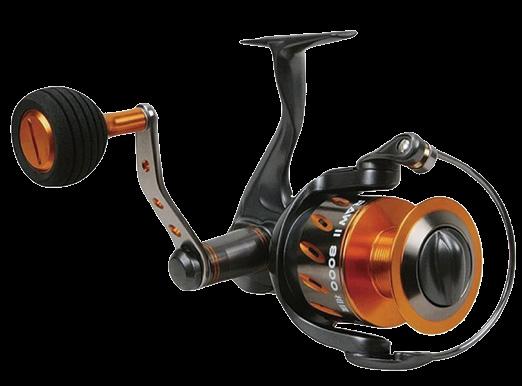
While baitcasters have a steeper learning curve, there are certain types of fishing where they excel. When tuned properly, baitcasters deliver the most accurate casting possible. Another benefit to using a baitcasting reel is the ability to maintain pressure on the spool with your thumb while letting out line to prevent missing bites on the drop. The biggest drawback is the possibility of getting a “bird’s nest” tangle when casting if the spool begins to spin faster than your lure takes out line. However, once you learn how to use and tune them, preventing this with proper adjustment and a bit of pressure from your thumb on the spool becomes second nature.
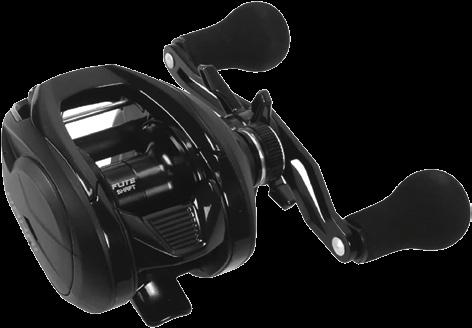
Conventional Reels – Used for bottom fishing and trolling, conventional reels come in a wide range of sizes for targeting everything from panfish to pelagics. Though many can be cast, most are designed for tactics where line is dropped or let out for trolling. It’s important to know that in some cases the lines get blurred between baitcasting and conventional reels, and there’s no dictionary definition separating the two. When you see the term “low-profile baitcaster” you know the reel is intended for casting, but these can also be used for bottom fishing or trolling and it’s not improper to refer to them as conventional reels since they have revolving spools. Lastly, some conventional reels are level-winding. This means that they have a level-wind mechanism that goes from side to side on a worm gear, to ensure the line lays evenly on the spool rather than bunching up in one place. Without this the line must be directed onto the spool with your thumb to keep it evenly laid on from side to side. However, level winders can’t take the heat of large offshore pelagics that can rip hundreds of feet of line from a reel in a run, and are generally reserved for inshore or freshwater use.

The basic specs you’ll commonly see for all these types of reels are size, gear ratio, drag, line capacity, ball bearings, and weight. As for size, spincast reels are generally small and intended for freshwater or light-duty saltwater fishing with model number sizing differing by manufacturer, but larger numbers indicate larger size reels. Spinning reels are all offered in sizes by the thousand with most companies providing half-sizes such as 1000 and 1500. Often the main difference in half-sizes is having a larger spool. A 500 or 1000 size reel is the smallest with a 20000 being the largest. Most freshwater spinning reels come in 1000 to 4000 sizes, saltwater inshore reels typically span from 1000 to 6000, and most offshore reels range from 5000 to 10000 with a few going all the way to 30000. Low-profile baitcasters are sized by the hundred and range from 50 to 500. Since they span everything from tiny panfish reels to giant offshore reels conven-
tionals are a bit more complicated and vary greatly amongst brands and models. But they still follow the basic model of larger numbers being larger reels. Particularly large offshore models may be offered with multiple drag options, speeds, and widths. Conventional reels come in star- or lever-drag models, with lever drags generally considered superior for big-game fishing since they allow for one-finger drag adjustments during the battle. Another unusual component of offshore conventional reels is gearing; some are offered in two-speed models, which means you can switch between a high and low gear ratio much like when riding a bike. Some reels will also have an “N” or “W” in the model name notating a narrow spool or a wide spool. Narrow spools are often offered to make them lighter and allow for easily and evenly laying line on the spool. Wide spools are typically found on larger trolling reels and increase line capacity.
The gear ratio deals with speed and indicates retrieval rate of the reel. The gear ratio will be written as a ratio which indicates how many times the spool or bail rotates per turn of the handle. For instance, a 6.3:1 means that for every turn of the handle the spool or bail rotates 6.3 times. A low gear ratio reel will have a slower retrieval rate and a high gear ratio reel will have a faster retrieve. Drag is a crucial element of a fishing reel, it’s the mechanism that determines the resistance put out by the reel when fighting a fish. Drag is measured in pounds and the “max drag” signifies the maximum number of pounds of resistance the reel has when the drag is locked down all the way. All spincast and spinning reels have the same drag concept, a knob or dial, usually (though not always) on the top of the spool, which is turned to tighten or loosen the drag. Some spinning reels have a live line drag system which is made
up of two separate drag knobs, which allows you to set a loose drag setting for when the fish picks up your bait and a tight drag for when the fight begins. Most low-profile casting reels have a star drag system controlled by turning a star-shaped wheel which is located between the handle and the main frame of the spool. As mentioned above there are multiple types of drag systems for conventional reels including star and lever drag.
Next is line capacity. Most reels have a small list on the spool showing the recommended line size and how much of each size you can fit. Poundtest is the first number which is either displayed as a number and (or) line diameter, followed by capacity which is measured in yards. The list will specify whether it is referring to braid or mono since braid has a much thinner diameter than mono relative to strength.
How smooth a reel is comes down to quantity and quality of the ball bearings. However, not all ball bearings are created equal. There is a correlation between price and the quality of the ball bearings. Many cheap reels contain lots of ball bearings and feel super smooth at first, but don’t last very long. Quality over quantity is the name of the game. There are three types of ball bearings: open, shielded, and sealed. Sealed are the best and provide the most corrosion resistance, shielded offer some protection against corrosion but will not last as long as sealed, and lastly open bear-
# Star drag at left, lever drag at right.
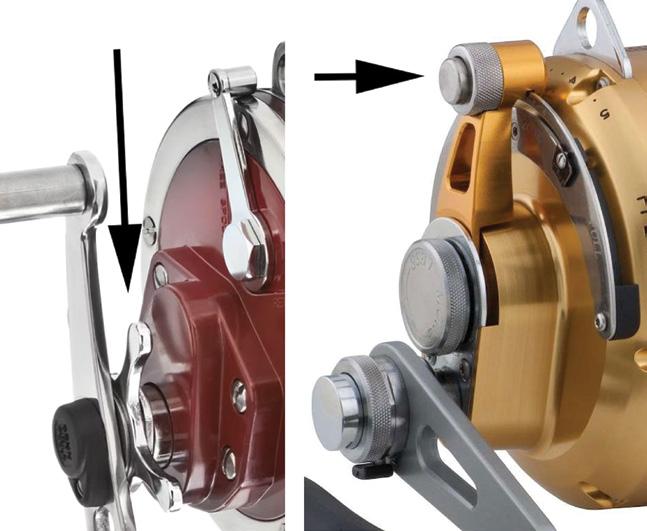
ings which will corrode and junk out the fastest. Reels with open bearings are best suited for freshwater and still won’t last as long as shielded or sealed bearings, especially when used in brackish waters of the Bay.
The weight of a reel is generally listed in ounces. There are many different materials and alloys that reels are made of, and modern reels have become extremely light. If you intend on primarily fishing with lures look for a lighter reel that won’t cause as much
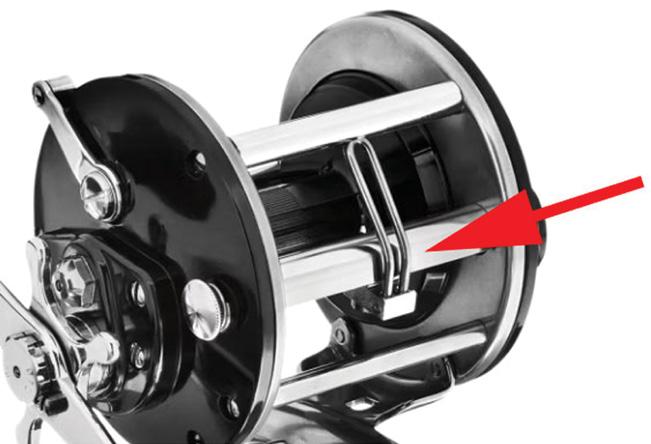
fatigue from casting all day. Heavier reels are best suited for casting bait and letting it sit, or for trolling. Reels at the higher price points will often weigh significantly less than midrange reels made with less advanced alloys. Very inexpensive reels may be light, but their plastic parts won’t last long.
Which reel is best for you?
First you have to decide what your primary use for the reel will be. Ask yourself what species you’ll target, if you’ll cast or troll, use bait or lures, and if you’ll be fishing from land or a boat, in freshwater or saltwater. Remember that it’s fine to use saltwater reels in freshwater venues, but not the other way around.
Also be realistic about your current skill level. Beginners who will be casting should probably start with a fixed-spool reel to minimize frustration, and begin practicing with a baitcaster when they want to improve accuracy. Inshore trollers will benefit from those level-winders. When you’re first getting started it’s usually best to accept the limitations of a reel that will make fishing easier and worry about advancing capabilities after you have some experience. Once you have narrowed it down you can begin to explore the options within your budget. #
Predicted after review of past reports gathered by Dillon Waters.
Editor’s Note: For timely, up-to-date reports, visit our website FishTalkMag.com. Current reports will be published every Friday by noon — just in time for your weekend fishing adventures.
Midsummer can mean hitting a bit of a doldrum offshore if the yellowfin all head north for cooler climates, but remember that in recent years bigeye have stuck around to one degree or another providing offshore anglers with a very big potential thrill. It’s a sure bet we’ll have plenty of mahi around by now, too, hopefully on the inshore grounds as well as out in the deep. Back on the beach things are likely to be on the slower side but panfish like kingfish and spot should be around to make casting in the suds a worthwhile endeavor.
In the heat of the summer we have three pieces of advice: fish early, fish late, and look for shade. You can be sure the fish will be as hot as we are, and much of the activity will be confined to when the sun is at its weakest and in areas where the fish can stay cool. This is a good time to head for the rivers, too, which tend to stay quite a bit cooler than still-water hotspots. One potential explosive exception: snakeheads. Look to find them in very thick, heavy cover right about now, where pulling a weedless topwater can work magic.
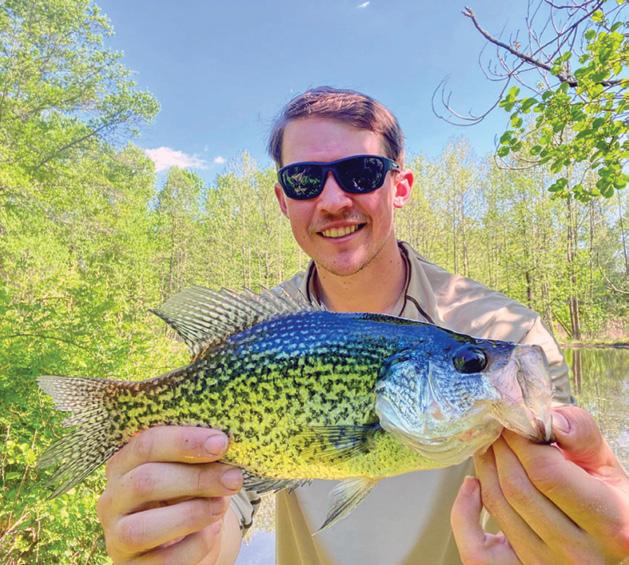
Remember folks, as of July 16 we go into shut-down mode for rockfish. On the bright side there should be plenty to catch in the Bay’s northernmost region, with bass and snakeheads on the flats and in the rivers. There’s been some excellent crappie fishing in the North East and the Elk in recent years, too, so don’t forget about that option. Those of you who want to feel a tug of a bigger — much bigger — sort, however, will be dropping baits along the channel edges from the Rt 95 bridge down to Perryville ISO monster blue cats.
As the striper closure commences midmonth there’s sure to be a big change in the fishing, with fish like white perch, blue cats, and snakeheads moving in to fill the gap. Considering how early the spot (including some of eating size) moved in this year we could also see good numbers of that panfish holding on Upper Bay oyster bottom, and with a little luck some of the bluefish will have continued a northern trajectory as well.
Will we see a return of the cutlassfish that appeared last summer? We sure hope so! We also hope there will be plenty of bluefish and maybe some Spanish mackerel around as the rockfish summer shut-down commences. There’s also a good shot that anglers fishing in the tribs will tie into puppy drum, which were steadily marching their way north when we went to press.
Anglers prowling the Lower Bay will undoubtedly be looking to find some of the Chesapeake’s largest inhabitants by this point in the summer: cobia and bull red drum. But remember that last July a wonderful speckled rout bite with redfish mixed in continued right through the month. Grassbeds, points, and shallow water structure was the ticket.
As July sets in there’s a chance the shallow water bite will slack off, but there should still be a good earlymorning bite window for specks and the potential to find them at slightly deeper structure once the sun’s high in the sky. Or, maybe we’ll get lucky and water temps won’t creep so high as the upper 80s — that’s certainly something we can’t predict. On the other hand, we can predict that there’s an excellent chance bluefish, Spanish mackerel, or both will be swimming around in the Sounds at this point in the season.
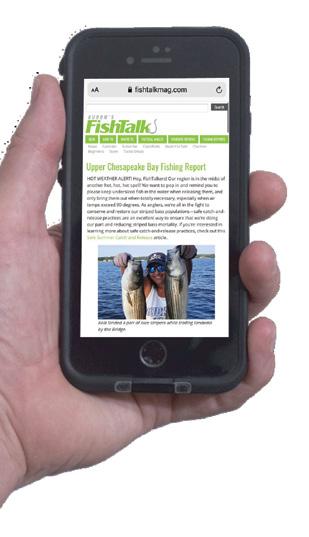

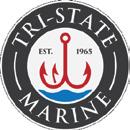
All the way down the Bay there’s bound to be red-hot action as we enter this red-hot time of year. Last season both cobia and bull reds were prolific in this zone, and there were big schools of huge reds cruising around near the CBBT islands. Let’s hope that happens again! And if not, don’t worry — flounder, blues, Spanish mackerel, sheepshead, and triggerfish should all be around in the Way South zone of the Bay.

# Julian got into a sweet cutlassfish bite last year - let’s hope those crazy critters return this summer.
by noon, just in time




Whether you’re doing a float down your local river, casting a line into your favorite reservoir, or plying the open Bay, safety should be your number one priority. Grabbing my personal floatation device (PFD) and putting it into my truck is the first thing I do before I load up any other gear for a day on the water. Well, I did forget it once… then I had to call my wife, Sandy, and ask if she would bring it to me at the lake. She was nice enough to do so, but not everyone is as lucky as me so what I’m saying is, don’t forget your PFD!
Most state regulations require that you have PFDs on your boat, but not all require you to wear them. I live in a state where you are required to have a PFD for each person onboard, and each life jacket must be in good condition and readily accessible. Which means it can’t be stowed in a closed hatch, have gear on top of it, or be in a plastic bag. Preferably, however, regardless of the requirements you’ll
be wearing your PFD each and every time you push off from shore.
Okay, enough about safety and regulations. So, let’s talk about life jackets. I polled several of my kayak fishing buddies, asking what type of PFD they own and the positives and negatives. Comfort was the first and foremost issue for those polled. They wanted them to be lightweight, and cool in the summer heat. They didn’t want to need their seat backs positioned leaning back, or for the jacket to be pushing them forward or poking them in the back. And they wanted pockets to store items that they would need for a day on the water. Most said that they also looked at how the life jacket was constructed. Prices for those polled ranged from $70 to a little over $300. The jackets I use are priced in the midrange.
What I have found, and most of my kayak fishing buddies have too, is that it’s best to spend a bit more cash and pick up a PFD specifically designed for kayak fishing. They come with a high
back or padding that has been adjusted and arranged to avoid pushing you forward or making it feel like you have something poking your back all day. They also come with pockets and tie-off loops to stow and attach critical items such as a whistle, knife, hemostats, safety radio, terminal tackle, and baits.
I personally like the Stohlquist Keeper jacket I am currently using, and I also own a Stohlquist Piseas. Both jackets have backs that don’t impede my comfort, they are cool, and they have plenty of pockets and attachment points. For really hot summer days I may use my West Marine inshore automatic/manual PFD, which is even slimmer and cooler. My friends that I polled own brands made by L.L. Bean, NRS, West Marine, Ascend, Mustang, and Kokatat.
Remember, a cast not taken is a fish not caught — and wear your PFD, because you’ll want to be around to take that next cast for a long time to come.
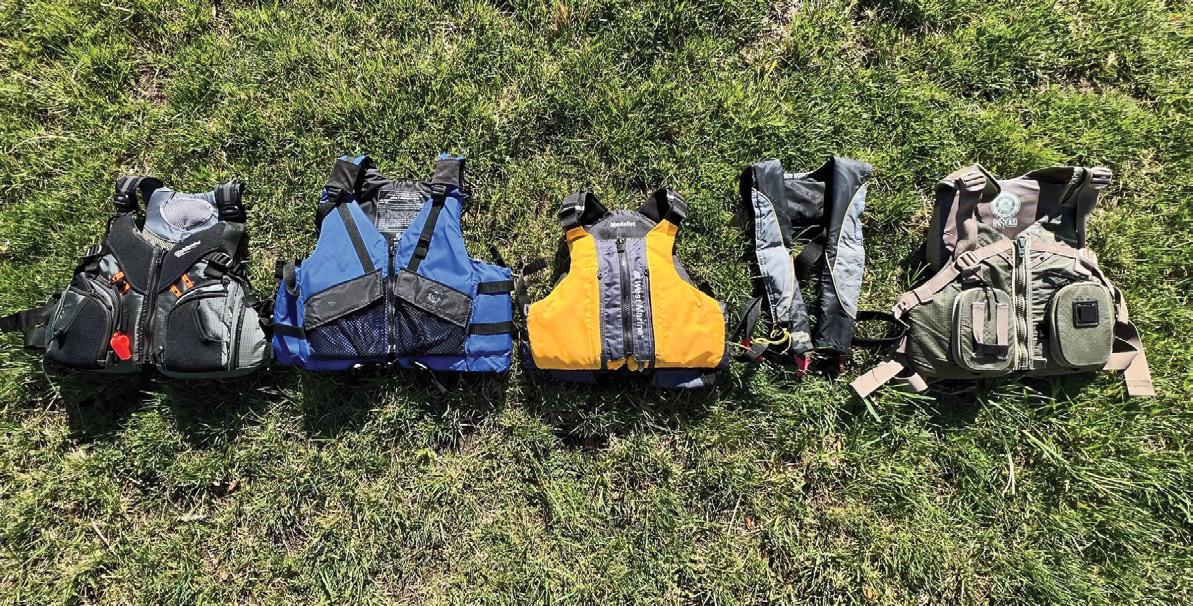
One of the most difficult ways to learn how to fish the Chesapeake Bay and Atlantic ocean is trial and error. Then there’s the boat issue; we don’t all have one. Luckily, the Bay is full of knowledgeable guides and charter captains ready to show you the ropes. Below you will find a directory of professional guides, charter boats, and head boats to get you started on your quest for the perfect fish. Whether you like to fly fish, troll, or bottom fish, there’s likely a local expert who can lend a hand.


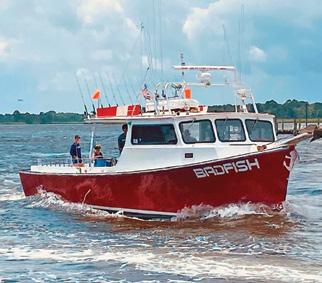




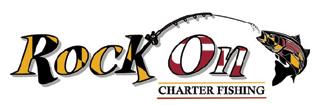


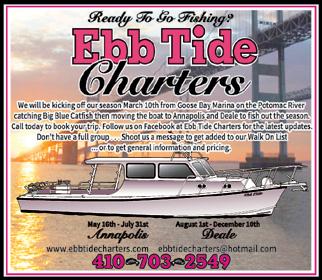

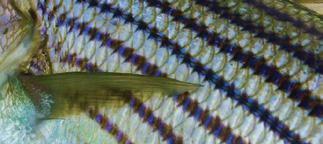










2023 Bayliner VR4OB 115 Pro XS Mercury outboard, Mercury Platinum Warranty until 2/6/28, Hours - 43, Karavan Galvanized Trailer w/ Spare Tire, Solid Rally Red Hull, vR Series Coastline, Boot Stripe, Bimini Top, ProArc Tower w/ Integrated Bimini Top, Bow Cover, Cockpit Cover, Storage Cover, Stainless Steel Upgrade, Cockpit Flooring - Teak Mat, Swim Platform - Teak Mat, Windshield w/ opening Walk-Thru, Jensen Stereo, Garmin 44Cv DF/FF/GPS, Automatic Bilge Pump, and more! $37,500 Riverside Marine, 410.686.1500, sales@riversideboats.com www.riversideboats.com #20810
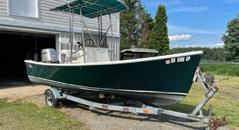
19’ Judge/Eastern Center Console Nice, clean, upper Bay boat located in Rock Hall, MD. Stainless steel top, GPS, 90Hp Honda outboard. $28,900 trailer included. Call for additional info and pictures 410.459.5670
2014 Tidewater 196 CC Yamaha F115 w/ 140 Hours. Trailer Included. $27,999 RT 113 Boat Sales 302.436.1737 www.rt113boatsales.net
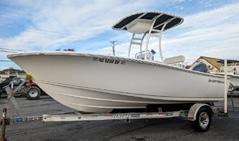
2016 Sportsman 19’ Island Reef Clean, low-hour boat w/ T-Top, Yamaha 115Hp. $32,999 w/ trailer. Beacon Light Marina 410.335.6200 sales@beaconlightmarina.com www.beaconlightmarina.com
2016 Tidewater 198 CC Yamaha F115. Trailer Included. $29,999 RT 113 Boat Sales 302.436.1737 www.rt113boatsales.net
2017 Mako Pro Skiff 19 CC Mercury 115 Four-Stroke w/ 126 Hours. Trailer Included. $19,990 RT 113 Boat Sales 302.436.1737 www.rt113boatsales.net
2016 Grady White 205 Freedom Yamaha F150XB - only 183 Hours. Trailer Included. $59,990 RT 113 Boat Sales 302.436.1737 www.rt113boatsales.net
2020 Bayliner VR5 4.5L 200 Mercruiser, 2020 Karavan Galvanized Trailer w/ Brakes and Winch, Bimini Top w/ Boot, Bow and Cockpit Cover, Garmin SCv DF/FF/GPS, 12v Adapter, Cooler Seat, Helm Bucket Seat, Cockpit table, Stereo, and more! $33,995 Riverside Marine, 410.686.1500, sales@riversideboats.com www.riversideboats.com #20867
2022 Bayliner VR5OB 115 4S Mercury outboard, Hydraulic Steering, Karavan Galvanized Single Axle Trailer w/ Brakes and Winch, Gray Hull w/ White Bottom, Bimini Top, Bow and Cockpit Cover, Stereo w/ Speakers, Bolster Seat, Helm Bucket Seat, Aft Jump Seats, 12v Adapter, Digital DF, Depthfinder, Swim Step, Bottom Paint, and more! $31,995 Riverside Marine, 410.686.1500, sales@riversideboats.com www.riversideboats.com #20818
2023 Robalo R202 EX 150XB Yamaha outboard, engine Warranty until 9/12/25, engine Hours - 7.1, 2023 Coyote Trailer, Green Hull w/ White Bottom, T-Top w/ electronics Box and Rocket Launchers, Simrad 7" GPS, Smart Craft Monitor, Digital DF, 12v Adapter, Trim Tab/Trim Gauge, Interior Lights, Stereo w/ (4) Speakers, Leaning Post, Bow Filler Board w/ Cushion, Aerated Baitwell, Rod Storage, Raw Water Washdown, PortaPotty (enclosed), and more! $64,995 Riverside Marine, 410.686.1500, sales@riversideboats.com www.riversideboats.com #20876
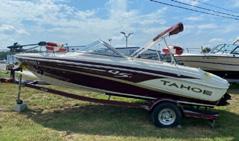
Tahoe Q51 20’ 2014 Mercruiser 4.3 MPI, Custom matched Tracker Marine Trailer, Galv. Shield Protected, oversized Padded Sundeck, Removable Fishing Chairs, Livewell. LoADeD and SUPeR CLeAN! $19,995 (Stock# U-339) Rudy Marine, 302.945.2254 www.rudymarine.com

Trophy Bayliner 20’ 2002 Mercury 150 2-stroke, Roller trailer, runs great, Cuddy cabin w/ toilet, well maintained. $9,995 oBo (Stock# U-361) Rudy Marine, 302.945.2254, www.rudymarine.com

2020 Yamaha 210 FSH Sport Great Family and Fishing boat! Twin Yamaha TR-1 Jet Drives w/ 210 hours. extended Warranty until 6/14/2025. $52,900 w/ 2022 venture Trailer. Beacon Light Marina 410.335.6200 sales@beaconlightmarina.com www.beaconlightmarina.com
2023 Sportsman Open 212CC F200XB Yamaha outboard, Custom Black engine, Yamaha extended Warranty until 7/13/25, Hours - 147, 2022 venture Aluminum Trailer, Shark Gray Hull w/ Jet Black Bottom, Black Powder Coating, Ash Gray Upholstery, Platinum Package, Slideout Track, Mooring Cover, Underwater Lighting, Garmin DF/FF/GPS, compass, Hour Meter, Trim Tabs/ Gauge, and more! $74,995 Riverside Marine, 410.686.1500, sales@riversideboats.com www.riversideboats.com #20744

2024 Boston Whaler 210 Montauk
A local favorite with lots of room fitting up to 9 people w/ bow cushions available for a very comfortable and dry ride. The 21 Montauk gets you into the 200Hp club which comes w/ digital throttling to make docking the boat that much easier. Lots of maneuverability for whatever the water activities you are enjoying this summer! Chesapeake Whalertowne 410.827.8080 www.whalertowne.com

2007 Sea Hunt 225 Victory Walkaround Alot of new recent upgrades including Minnkota Trolling motor setup! Yamaha F150 w/ 336 hours and a new F9.9 Kicker. $34,900 w/ 2022 Loadrite Trailer. Beacon Light Marina 410.335.6200 sales@beaconlightmarina.com www.beaconlightmarina.com
2021 Robalo Boats 222 CC F200XB Yamaha outboard, Yamaha extended Warranty until 3/5/26, Hours - 192, Coyote Aluminum Tandem Trailer w/ Brakes and Winch, Center Console Cover, Hard Top w/ electronics Box, Rocket Launcher, Spreader Light, Leaning Post, Compass, Simrad GPS, Simrad vHF, and more! $64,995 Riverside Marine, 410.686.1500, sales@riversideboats.com www.riversideboats.com #20677

2023 Defiance 220 Admiral very Nicely optioned ready for cold weather fishing. Yamaha Mechanical F250. $99,900 w/ trailer. Beacon Light Marina 410.335.6200 sales@beaconlightmarina.com www.beaconlightmarina.com
2023 Pathfinder 2200 TRS BLoWoUT LeFToveR PRICING! Yamaha F150. Boat Is Loaded and Ready to Go! Ameratrail Trailer Available. RT 113 Boat Sales 302.436.1737 www.rt113boatsales.net
For all the latest listings, visit fishtalkmag.com

2024 Boston Whaler 220 Dauntless Newly designed hull! Balanced perfectly between the local favorite 210 Montauk and the durability of the outrage hull model, this 22-foot boat just feels much bigger but w/ all the maneuverability, a little deeper v that can handle rougher waters. Big lounge seat up front w/ a massive storage locker underneath. Chesapeake Whalertowne 410.827.8080 www.whalertowne.com

22’ Grady-White ‘16 $79,500 Curtis Stokes 410.919.4900 curtis@curtisstokes.net www.curtisstokes.net

22’ Shamrock ‘99 $20,000 Curtis Stokes 410.919.4900 curtis@curtisstokes.net www.curtisstokes.net

Chaparral 226 SSI Wide Tech 2012 volvo Penta 5.0, Interior Seating in excellent condition, Bilge Pump, Navigational Lights, Bow Seating, Sun pad, Full Cover, Ski Tow Bar, New Bottom Paint. $29,999 (Stock# U-406) Rudy Marine, 302.945.2254, www.rudymarine.com
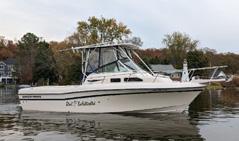
2000 Grady White 232 Gulfstream overall great fishing platform w/ a comfy cabin and wide beam! Single Yamaha 225 oX66 2 Stroke. $34,900 (No Trailer included). Beacon Light Marina 410.335.6200 sales@beaconlightmarina.com www.beaconlightmarina.com
2023 Sportsman Open 232CC F250XB Yamaha outboard, engine Warranty until 10/20/25, Hour Meter - 214, venture Aluminum Trailer, Sea Glass Green Hull w/ White Bottom, Desert Tan Upholstery, White Powder Coat, Platinum Package, Second Garmin GPSMAP 943xsv MFD 9”, Garmin Fandom Radar, Under Leaning Post Tackle Storage, ShipsDek Flooring, Minnkota Trolling Motor System, and more! $94,995 Riverside Marine, 410.686.1500, sales@riversideboats.com www.riversideboats.com #20652

Trophy Bayliner 23’ 2302WA
2000 Mercury 225 optimax, Loadrite roller trailer, hard top w/ electronic box, runs great, cuddy cabin w/ toilet, wellmaintained. $19,995 oBo (Stock# U-332) Rudy Marine, 302.945.2254, www.rudymarine.com

2019 Cutwater C242 Sport Coupe $94,987 Priced to Sell! 300Hp YAMAHA. equipped w/ Aft Cockpit Sunshade, AC, Bow Thruster, Garmin GPS Chartplotter w/ depth sounder, electric Grill, and more! Call Josh Miller at 810.531.9191 or jmiller@pocket-yacht.com www.pocketyachtco.com
2022 Bayliner Trophy T24CC 250 4S Mercury outboard, Mercury Warranty until 7/16/25, Hours – 30, Power Assist Steering, (new trailer shown in photos is available for $6,746), Graphite Interior, Stainless Steel Upgrade, Ski-Tow Pylon, Center Console and Helm Seat Cover, Bow Filler Cushion, CC Fishing Seats with Livewell, Digital Dash with Mercury vesselview inkTwin 9” GPS, and more! $69,995 Riverside Marine, 410.686.1500, sales@riversideboats.com www.riversideboats.com #20671
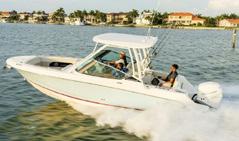
2024 Boston Whaler 240 Vantage
Another Chesapeake Bay icon of the Boston Whaler family is our 24 vantage. Perfect ski boat for the family, fits 11 people and has a top speed of nearly 50mph. every Whaler is built w/ a foam filled hull, so this unsinkable legend is one of the safest boats on the water. Chesapeake Whalertowne 410.827.8080 www.whalertowne.com
2024 Pathfinder 2400 TRS Yamaha F300XSB2. Trailer included. RT 113 Boat Sales 302.436.1737 www.rt113boatsales.net
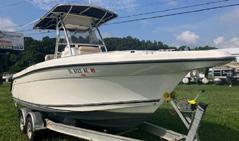
Century 24’ 2400CC 2007 Yamaha F250 4-stroke, venture aluminum Trailer, T-tops w/ electronics box, new cushions, head compartment w/ toilet, well-maintained, low hours. $39,999 oBo (Stock# U-381) Rudy Marine, 302.945.2254, www.rudymarine.com

Twin Vee 24’ 240DC 2024 Twin 150 4-stroke Mercury, new custom fitted alum. Loadrite trailer, dual console, powder coated hard top, full head compartment w/ toilet, super load, 9 hours. $149,999 oBo (Stock# U-390) Rudy Marine, 302.945.2254, www.rudymarine.com
For all the latest listings, visit fishtalkmag.com
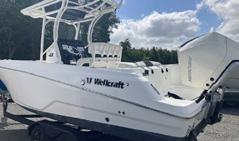
Wellcraft 24’ 242 Fisherman CC 2020 Mercury 250 verrado, new alum. Loadrite trailer, powder coated hard top, head compartment w/toilet, low hour, super loaded. $57,996 oBo (Stock# U-396) Rudy Marine, 302.945.2254, www.rudymarine.com

(Key Gull) 25’ Carolina Classic ‘06 $49,000 Curtis Stokes 410.919.4900 curtis@curtisstokes.net www.curtisstokes.net
2017 Sportsman Open 252 CC Twin F150XB Yamaha outboards, venture Trailer 7225, White Hull, Black Powder Coat, Hard-Top w/ Rocket Launchers, Spreader Light and outriggers, Spray Shield, Simrad 12” GPS, Simrad vHF, Compass, Hours - 570, Trim Tabs / Trim Gauge, Bottom Paint, Lots of extrasmore to come! $99,995 Riverside Marine, 410.686.1500, sales@riversideboats.com www.riversideboats.com #20803
2021 Sportsman Open 252 CC Twin F150XCA Yamaha outboards, Yamaha extended Warranty until 2/2/26, Hours - 631, (display 2021 venture trailer available for add'l $5,000), Shark Gray w/ White Bottom, Hardtop w/ electronics Box, Rocket Launchers, Spreader Light, and outriggers, Windlass, Underwater Lighting, Trim Tabs/Trim Gauge Auto Pilot, (2) 12" Garmins, Minnkota Ultera 10' Power Pole, electric Trolling Motor, Boatel Kept! $119,995 Riverside Marine, 410.686.1500, sales@riversideboats.com www.riversideboats.com #20628

2024 Boston Whaler 250 Dauntless For boaters seeking a higher-quality bay boat experience, the all-new 250 Dauntless raises the bar. Smooth-riding performance and a spacious center console layout combine w/ amenities for fishing, watersports, comfortable offshore cruising and beyond. From the inviting bow lounge to the sleek redesigned hull, the 250 is more than just confident - it’s dauntless. Chesapeake Whalertowne 410.827.8080 www.whalertowne.com

2024 Boston Whaler 250 Outrage Powered by twin 300 v8s - This incredibly dry haul even in the worst of seas is truly a well thought out design. our 250 outrages are equipped with the fishing package, including rod holders, a livewell, fresh and raw water washdowns, and a tackle storage center. Safety factors - self-bailing cockpit, stainless steel grab rails, and tempered glass windshields provide peace of mind for you and your crew. Chesapeake Whalertowne 410.827.8080 www.whalertowne.com

Aquasport 25’ 2500CC 2020 Twin F150 4-stroke Yamaha, venture alum. trailer, radar, twin Simrad, head compartment w/ toilet, and much more. Super low hours. $89,995 oBo (Stock# U-365) Rudy Marine, 302.945.2254, www.rudymarine.com
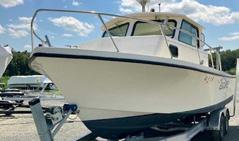
Parker 25’ 2520 Pilot House 1993 Yamaha 250Hp, Karavan aluminum trailer, solid floor and transom, super clean, awesome 6pack boat. $39,999 oBo (Stock# U-389) Rudy Marine, 302.945.2254, www.rudymarine.com
2024 Pursuit S268 Sport Twin Yamaha F200XSB. Trailer Available. RT 113 Boat Sales 302.436.1737 www.rt113boatsales.net

Cutwater 26’ C-26 2016 volvo Penta in-board diesel, new customer fitted Loadrite aluminum trailer, super loaded boat, like new condition, super low hours. $149,995 oBo (Stock# U-395) Rudy Marine, 302.945.2254, www.rudymarine.com

Jeanneau 26’ 7.5 CC 2022
Yamaha F300 4-stroke, white powdercoated T-top, Garmin electronics, Fusion stereo, electric windlass, bow thruster, head compartment w/ toilet, under 40hrs., super clean. $99,995 oBo (Stock# U-387) Rudy Marine, 302.945.2254, www.jeanneauboatsforsale.com

(Reel Blessed) 28’ North Coast ‘21 $239,000 Jack Kelly 609.517.2822 jack@curtisstokes.net www.curtisstokes.net

2017 Boston Whaler 285 Conquest
$274,987 Fully loaded and IMPeCCABLY maintained 2017 Boston Whaler 285 Conquest. Twin 250Hp Mercury verado’s - only 320 hrs. Lift kept, single owner boat. Call Josh Miller at 810.531.9191 or jmiller@pocket-yacht.com www.pocketyachtco.com
2020 Pursuit S288 Sport Twin Yamaha F300 w/ 90 hours. Trailer Included. $255,000 RT 113 Boat Sales 302.436.1737 www.rt113boatsales.net

2023 Boston Whaler 280 Dauntless our 28 Dauntless here is the perfect combination of fishability and family cruiser. equipped w/ retractable aft sunshade and bow sunshade that is very quick and easy to install - this single-engine 400Hp is more than enough juice to run across the bay even in the worst of conditions. Sale Pending. Chesapeake Whalertowne 410.827.8080 www.whalertowne.com

2024 Boston Whaler 280 Outrage Powered by twin 400 v10s - This incredibly dry haul even in the worst of seas is truly a well thought out design. equipped with the fishing package, including rod holders, a livewell, fresh and raw water washdowns, and a tackle storage center - The 280 is a self-bailing cockpit, stainless steel grab rails, and a tempered glass windshields providing peace of mind for you and your crew. one difference in the layout of the deck is the 280 outrages offers a large lounge in the bow seating areachildren and ladies first notice and their favorite part of the boat. Chesapeake Whalertowne 410.827.8080 www.whalertowne.com
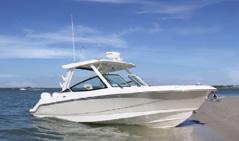
2024 Boston Whaler 280 Vantage Beautiful classic white hull with chrome decals, big enough to host the entire family including aunts and uncles - the twin 300s that will reach almost 60mph! Plenty of room to host for any occasion or head out and catch some local rockfish out on the Bay. A must see! Chesapeake Whalertowne 410.827.8080 www.whalertowne.com

Chaparral OSX 280 2021 Twin Yamaha 200Hp 4-stroke, Power Arch w/ Canvas Bimini top, Grey Sea Deck Flooring, Lenco Trim tabs, Windlass, optimus 360 Joystick. $149,500 (Stock# U-404) Rudy Marine, 302.945.2254, www.rudymarine.com
2014 Cobia 296 CC Twin Yamaha F300's w/ 765 Hours. Trailer Included. $114,999 RT 113 Boat Sales 302.436.1737 www.rt113boatsales.net
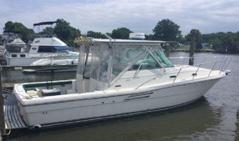
(Hot Pursuit) 30’ Pursuit 3000 ‘00 $49,000 Curtis Stokes 410.919.4900 curtis@curtisstokes.net www.curtisstokes.net
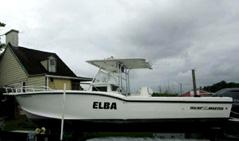
(Elba) 31’ Ocean Master ‘98 $79,500 Curtis Stokes 410.919.4900 curtis@curtisstokes.net www.curtisstokes.net

2000 Formula 31 PC FULLY LoADeD! T/5.7L 310Hp Mercruiser FWC, B3, Kohler gen, AC/HT, Raymarine axiom, Quantum radar, full canvas & isinglass, sleeps 6. Well-maintained w/ $11K recent work. Kept indoors. $50,000 202.798.0443 or jperez9630@gmail.com
2018 Sportsman Open 312 CC Twin 300 Yamaha outboards, custom painted White, engine hours: 639, (New Tri-axle Trailer available for $11,129), optimus electric Power Steering, 2x Simrad NSS16” evo3 MFDs, Simrad Dome Radar, Simrad RS35 vHF. Service fully up to date, records on hand. $177,995 Riverside Marine, 410.686.1500, sales@riversideboats.com www.riversideboats.com #20745
2004 Stamas 320 Express Twin 225 Yamaha outboards - White, Hours-795, (no trailer), Light Blue, Full Curtains and Slant Back Cover, Snap-in Cockpit Cover, Tackle-Prep Station w/ Fresh Water Spray, Fresh Water Tank - 40 gal, Spotlight on Hardtop, Hardtop Sun Shade (covers entire stern), Garmin 12" Touchscreen GPS, vHF, Stereo System, Anchor Windless, Full Cabin w/ Galley, Dinette (converts to v-Berth), Aft Berth, enclosed Pump-out Head (discharge capable), Shore Power w/ Battery Charger, Underwater Lights, very Clean and Well Maintained! $89,995 Riverside Marine, 410.686.1500, sales@riversideboats.com www.riversideboats.com #20874

2021 Cutwater 32CB $349,000 “Red Knot” is New to the market. Meticulously maintained, Features A/C, Bow Thruster, Dinghy, GPS Plotter, Depth finder, Radar, and more. Call Robert Tolbert at 443.595.6210 or robtolbert@pocket-yacht.com www.pocketyachtco.com

2024 Boston Whaler 320 Vantage This is our 320 vantage, and comfortably fits 14 people. An adjustable port lounge gives you lots of options for your boating enjoyment. Bluetooth ready. 3/5/10 year warranty available. Chesapeake Whalertowne 410.827.8080 www.whalertowne.com
2024 Pursuit DC326 Twin Yamaha F300NSB. Yamaha Helm Master Joystick w/ Autopilot. Generator, Air Conditioning, Full electronics Package. RT 113 Boat Sales 302.436.1737 www.rt113boatsales.net
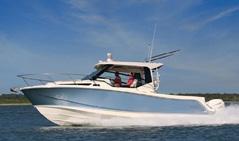
2024 Boston Whaler 325 Conquest Fish, cruise, never have to choose. With the new 325 Conquest, “split personality” takes on a whole new meaning. This adventurous boat is so much more than a cabin cruiser - Designed for maximum versatility, the 325 offers purposeful amenities for all your favorite activities. The conquest offers ultra-convertible port lounge, full front glass windshield for incredible visibility, and a spacious cabin perfect for overnighting. Chesapeake Whalertowne 410.827.8080 www.whalertowne.com

2024 Boston Whaler 330 Outrage Built for the ocean but easy enough to handle through ego alley downtown Annapolis! equipped w/ white 400Hp v10 engines to maximize performance on our newly designed outrage. Chesapeake Whalertowne 410.827.8080 www.whalertowne.com
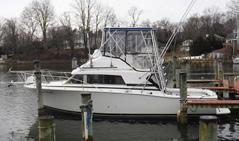

36’ Nauset ‘90 $98,000 evan
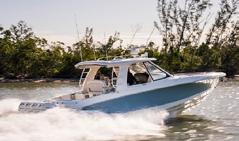
for three-day-a-month magazine distribution routes in Maryland (immediate need: Annapolis route). Compensation based upon quantity of stops. Must have a valid driver's license in good standing, reliable vehicle, and be able to lift up to 25 lbs. For more info, please email info@fishtalkmag.com

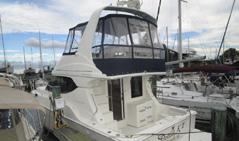
33’ Bertram ‘80 $45,000 Curtis Stokes 410.919.4900 curtis@curtisstokes.net www.curtisstokes.net (Dottie K) 34’ Silverton ‘05 $119,000 Curtis Stokes 410.919.4900 curtis@curtisstokes.net www.curtisstokes.net
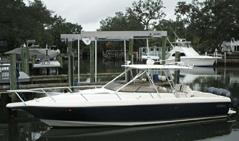
34’ Intrepid ‘01 $145,000 Curtis Stokes 401.919.4900 curtis@curtisstokes.net www.curtisstokes.net

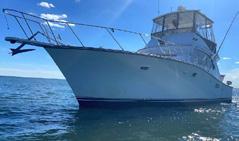
Seeking P/T Magazine Delivery Drivers for three-day-a-month magazine distribution routes in Maryland (immediate need: Annapolis route). Compensation based upon quantity of stops. Must have a valid driver's license in good standing, reliable vehicle, and be able to lift up to 25 lbs. For more info, please email info@fishtalkmag.com
Yacht Sales - Curtis Stokes and Associates, Inc. is hiring new salespeople for our Chesapeake area operation. Candidates must be honest, ethical and have boating experience. This is a commission only position. Contact Curtis Stokes at 410.919.4900 or curtis@curtisstokes.net www.curtisstokes.net




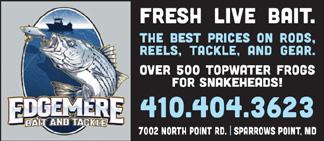


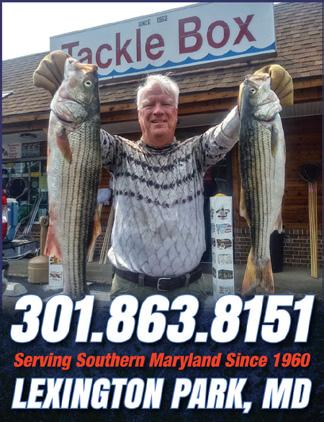
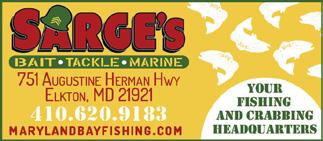
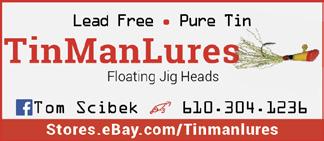

Tri-State Marine (TSM) Annapolis has announced the relocation of their Annapolis location to the heart of the Maritime Republic of Eastport at 222 Severn Avenue on Spa Creek. Here, you’ll find TSM's recently renovated, 5200 square foot indoor boat showroom featuring many new models of Grady-White Boats and Parker Boats. This is the only indoor boat showroom of its size in all of Annapolis, and it features 125 feet of direct waterfront on Spa Creek making the new showroom accessible by boat or water taxi. There’s also a ton of history at this property. 222 Severn is the former site of the historic Annapolis Yacht Yard, which built 70-foot Vosper Torpedo Patrol Boats for the British Navy during the early 1940s. Later, in 1948, it was home to the John Trumpy & Sons Yacht Yard, known around the world for its exquisite hand-crafted yachts of mahogany and bronze. The most famous is Sequoia, built for President John F. Kennedy. Conveniently located near Safe Harbor Annapolis, Annapolis Yacht Club, Eastport Yacht Club, and South Annapolis Yacht Centre, you’ll find it hard to resist stopping by to see your next Grady-White or Parker Offshore model and then celebrating your new boat at the many great restaurants nearby, including Chart House Prime, O’Learys Seafood, Lewnes’ Steakhouse, Boatyard Bar & Grill, and Carrol’s Creek Cafe! Tri-State Marine would like to thank its customers for their continued support as they find new ways to support the greater Chesapeake Bay region’s maritime community. tristatemarine.com
Legasea Marine in Yorktown, VA, has been appointed as a Mid-Atlantic dealer for Axopar Boats. Axopar’s award-winning boats are renowned worldwide for their modern styling, exhilaration to drive, fuel efficiency, and undeniable value. With this agreement, Legasea Marine expands its new boat brand offerings to include Axopar’s complete lineup in five size ranges: 22, 25, 29, 37, and 45. Founded in Finland in 2014 and recipient of NMMA’s Customer Satisfaction Index Award for 2023, Axopar has built more than 6000 boats through a network of more than 100 dealers in more than 50 countries. “We are thrilled to offer our customers Axopar’s exceptional lineup of highly functional vessels that represent the epitome of Scandinavian design and engineering excellence,” commented Chris Hall, president and co-owner of Legasea Marine. “Axopar’s commitment to quality and adventure aligns perfectly with our values, and we look forward to providing boaters with unrivaled on-water experiences.” Johan Holm, head of sales for Axopar Boats, says, “Welcoming Legasea Marine as our newest dealer in the U.S. is very exciting for us! We look forward to seeing a lot of new Axoparians on the waters with the help of their experienced sales team.”
Axopar’s design team explored the idea of using their creations for more than just boating. Whether transporting a multitude of gear for a day of fishing or diving on a wreck, surfing, biking, or camping on an out island, Axopar boats excel at getting the most out of a day in the great outdoors. Modularity, designed for discovery and escapism, is the brand’s standout strength as customers can specify a deck and interior that perfectly suits their needs for anywhere their adventures may take them. Legasea Marine has committed to a full floorplan of Axopar models and the first new boats should begin arriving on-site later this summer. legaseamarine.com/ axopar-boats
Annapolis Electric Boat Rentals has recently joined the SeaDC group of companies. This adds two new locations in Baltimore and Washington, DC, but rest assured, there will be the same great experience you’ve come to expect at each location. Annapolis Electric Boat Rentals, LLC offers a unique and exciting way to tour the water. These eco-friendly vessels are battery operated and offer the ability to experience a day on the water in a silent luxurious boat that you drive yourself. Boats comfortably seat 10 adults and are safe for all ages. Rent from one to three hours and bring your own food and beverages (including alcohol); great for special events. These boats feature a fully enclosable window system, life vests, and all Coast Guard approved safety gear. Guests must be 21 with a valid driver’s license and credit card to rent. aebrentals.com
s end your c hesapeake Bay business news and high-resolution photos to kaylie@fishtalkmag.com